
|
|
Alan Allbon’s Debut Design - the Allbon 2.8
However, Allbon got his start in the model engine field working independently through his own company under his own name. In the present article, I'll take a close-up look at Allbon's debut as an independent manufacturer in his own right, which took the form of the 1948 Allbon 2.8 sideport diesel. A detailed account of Allbon’s life and work from start to finish may be found elsewhere on this website. However, that account is essentially biographical in nature, hence lacking technical details or test results on any of Allbon’s early model engine designs. The present article will address that deficiency for the period leading up to the end of 1949. A second follow-on article will carry the story through to late 1952, when Allbon ceased to be an independent model engine manufacturer in his own right. The original text of these articles covering the early years at Allbon was published as a single article in December 2012 on Ron Chernich’s enduringly informative but now long-frozen “Model Engine News” (MEN) website. Since that date I’ve become far better informed with respect to the career of Alan Allbon, going right back to the very beginning. My main source of this information has been a series of lengthy telephone conversations with Alan Allbon’s eldest son Kenneth (b. 1939). We are all very much in Kenneth’s debt for his sharing of this information, which would otherwise have been irretrievably lost. I'm also extremely grateful to Kenneth for painting the accompanying portrait of his father especially for use as an illustration for my various articles. The revised text on Allbon’s early years in the model engine field had to be presented here given the now-frozen state of MEN. In view of its expanded length due to the volume of new information, I’ve chosen to present it here as two successive articles which together tell the story. The first of these two articles which you’re now reading will cover the sideport Allbon 2.8 with which Allbon got started, while the second piece will deal with the early crankshaft front rotary valve (FRV) models developed by Allbon during his early years as an independent model engine manufacturer in his own right before circumstances arose which forced a merger with Davies-Charlton (D-C) Ltd. Before getting started, I must acknowledge the outstanding assistance rendered by both David Owen and Ron Chernich of Australia during the preparation of the original text in 2012. Sadly, neither of these greatly valued and much-missed friends and colleagues are still with us, but prior to their respective departures they were both most generous in providing images, test reports, advertisements and general information in their possession. No request of mine for assistance went unanswered. My other valued Aussie mate Maris Dislers was equally generous with the time spent assisting me. I must also thank Eric Offen and Tim Dannels for their kind provision of images and serial numbers. Without such cooperation, these articles would lack any semblance of authority. Thanks, guys! With those acknowledgements clearly stated, let's explore the background to the Allbon 2.8 story............. Background
In the present article, I’ll pick up the story in the immediate aftermath of WW2. The conclusion of the war found Allbon working independently under the company name of Allbon Engineering Co. (Sunbury) Ltd. in premises which he had established prior to the outbreak of war at 51a Thames Street in Sunbury-on-Thames. This community was located on the north bank of the River Thames a little to the west of London in the county of Middlesex, although it was later incorporated into the county of Surrey as part of the 1965 county boundary reorganization resulting from the work of the Royal Commission on Local Government in Greater London. In the first few years after the war, the now thirty-nine year-old Allbon resumed his pre-war activities by working in the general precision engineering field, presumably for the most part under contract to others. However, it’s clear that by 1947 he was ready for a change in focus. His long-standing mechanical interests had combined with his parallel interest in modelling to make the prospect of entering the then-developing field of model engine manufacture seem very attractive. Naturally, his engineering design skills and long experience in the field of precision engineering equipped him admirably to undertake the design and manufacture of model engines. He had also assembled a good inventory of machine tooling which could be applied to this venture.
Allbon’s ongoing hands-on involvement in aeromodelling doubtless gave him ample opportunity to examine the products of some of the manufacturers with whom he would be competing. He must surely have been familiar with such pioneering model diesels as the E.D. 2 cc sideport models from Kingston-on-Thames, the Mills 1.3 from Woking, the FROG range manufactured by International Model Aircraft (IMA) at Morden and the Kemp range from Gravesend in Kent. These models must have given him much to think about when considering his own designs.
The Allbon workshops at the Thames Street premises in Sunbury were very small by comparison with those of their major rivals from across the river. The building formerly housed a shop of some kind. Kenneth Allbon recalled that to maximize the efficient use of floor space, the entire second floor of the building had been removed, creating a ground floor of twice the original height. This was very convenient for the accommodation of the machinery used by the company. A flight of wooden stairs led up to a small elevated cubicle-style office which was located at the former second floor level in one corner of the building. This was Alan Allbon’s design and business office. This “suspended office” arrangement saved some space on the main floor, which could thus be used in its entirety for manufacturing purposes.
There's no doubt that the Allbon model engine manufacturing enterprise began quite modestly in terms of production capacity. The production figures achieved at this stage were seemingly comparable with, say, those for the Kemp workshops in Gravesend, Kent, which operated with a staff of three full-time employees (including owner Harold Kemp) plus one part-timer. Indeed, Kenneth Allbon has confirmed that to his knowledge his father never employed more than four additional workers at this location at any time. At the outset, staffing levels were doubtless even less. The first model to appear was the Mk. I version of our main subject, the Allbon 2.8 cc sideport diesel. Let's begin our in-depth review of Allbon's early work by taking a close look at this design. The First Allbon Product: The 2.8 Mk I diesel
There was also localized competition from a number of small-scale manufacturers who mostly sold their products in their immediately-surrounding areas - Aerol Engineering of Liverpool (later famous as the makers of the Elfin engines) was one of these, as were Edward Reeves of Shifnal in Shropshire, H-P of Barnet in Hertfordshire and Majesco Motors of Parkstone in Dorset. It was thus important for Allbon to get it right first time - initial impressions can make or break a newly-formed commercial enterprise, particularly in the face of well-entrenched competition.
As far as I can determine, the initial national announcement of this model took the form of its inclusion in Henry J. Nicholls' advertisement in the February 1948 issue of "Aeromodeller" magazine. This advertisement is reproduced below at the right. Alan Allbon seems to have enjoyed a positive personal relationship with Henry J. Nicholls, since Nicholls’ Mercury Model Aircraft Supplies Ltd. of 308 Holloway Road in London acted as the trade distributor and service provider for Allbon from the outset. Allowing for sufficient editorial lead time to facilitate the development and submission of this advertisement, the implication is that the Allbon 2.8 must have made its initial appearance no later than December 1947.
It seems that prior to that point in time Mercury Model Aircraft Supplies had been able to absorb all of Allbon's limited production, most likely by supplying initial demand in the Greater London area either over the counter at "308" or through distribution to other London- The Allbon 2.8 sold for the reasonably competitive price of £4 16s 0d. (£4.80 in "modern" money). By way of comparison, the competing E.D. 2.49 cc Mk. III sold for £5 10s 0d (£5.50) at the same time. The Allbon's price was clearly acceptable to consumers, since the market evidently absorbed all of the limited production which Allbon was able to achieve from his modest Sunbury premises. The Allbon 2.8 was sold in a sturdy cardboard box with a rather plain but clearly-printed and quite informative label.
To present-day modellers, both the 2 cc and 2.8 cc displacements appear offside, although the 2.8 cc figure for the Allbon seems particularly so. To understand this point, it's essential to look at the matter in a 1947 context rather than from a present-day viewpoint. As of late 1947, competition aeromodelling in Britain was still very loosely organised in terms of displacement categories. In particular, the British Society of Model Aeronautical Engineers (S.M.A.E.) had yet to establish any formal competition classes based upon engine displacements, while the "magic" displacement of 2.5 cc (0.15 cu. in.) was some years away from being adopted by the FAI for International competition. Consequently, no particular displacement really had much of an edge over another in terms of consumer appeal or competition applicability. The only issues were what size of model was desired and whether or not a given engine could do the job of flying that model to the standard required. As a result, at the time in question engines having all kinds of odd-ball displacements were routinely being released in Britain. Seen in this late 1947 context, there was actually nothing at all extraordinary about Allbon Engineering releasing a new model having a displacement of 2.8 cc. It was only later, when the 2.5 cc limit was formally adopted by the S.M.A.E. for their respective Class II and Class A control line speed and team race events and was subsequently taken up by the FAI for International competition, that the attention of manufacturers became progressively more focused on engines built to the new competition limits and the 2.8 cc displacement category became something of an orphan which did not conform to any particular competition class. By that time the Allbon 2.8 had been withdrawn from production in any case.
I previously highlighted the marked underlying resemblance of the Allbon 2.8 to the E.D. Comp Special which was one of its main competitors at the time. This similarity was carried over to the crankshaft, which featured a heavily counterbalanced web to help control the inevitable vibration resulting from the rather heavy cast iron piston. The crankpin had a very substantial diameter of a full ¼ in. - no shortage of strength there! In fact, the crankshaft as a whole was far more sturdy than that of its admittedly smaller-displacement E.D. counterpart.
The fragility issue was somewhat exacerbated by the fact that the casting alloy used by Allbon throughout this period appears to have been of rather indifferent quality. All of the original Allbon models suffered from a tendency to break mounting lugs and other cast features, perhaps explaining why a certain proportion of those that were actually used in the field seem to have suffered crankcase damage of some kind. This is as true for the later Arrow, Javelin Mk. I and Dart Mk. I models as it is for the 2.8. More of those designs in a separate companion article. Like the E.D. models, the front cover incorporating the relatively long main bearing housing was attached to the crankcase by four 6BA screws. Again, the comment may legitimately be made that the Allbon's front cover was far less sturdy than that of its E.D. contemporaries, seemingly possessing rather marginal crash resistance. The main bearing itself consisted of a pair of white metal bushings pressed into the ends of the long main bearing housing. This was in contrast to the E.D. designs, which used cast iron bushings in a considerably shorter housing.
In common with a number of contemporary British engines, the prop driving face was not knurled in any way, reliance being placed upon friction between the prop and the faces of the driver and spinner nut. Presumably the idea was that this would allow for some slippage in the event of a crash, thus protecting the engine's working parts from crash damage. A pair of holes was drilled axially through the drive surface in case an owner wished to add the security of a pair of pins to lock the prop. Unlike the E.D. with its conventional one-piece piston design, the Allbon used a composite piston construction in which the gudgeon (wrist) pin and conrod were mounted in a separate aluminium alloy yoke. This was secured inside the piston using a countersunk screw through the piston crown. The arrangement eliminated the appearance of the ends of the gudgeon pin at the piston surface, thus preventing any possibility of the pin fouling the transfer or induction ports. According to the company literature, the final lapping of the piston into the cylinder was completed after the installation of the carrier to allow for any distortion during assembly.
Another potential problem stems from the differential thermal expansion coefficients for the two materials involved. Once the engine got well warmed up, I could foresee the alloy yoke exerting a considerable expansive pressure against the inner piston wall, causing a piston that was well fitted when cold to become tight when hot. My own Mk. II example (which has had very little running) may possibly suffer to a degree from this problem, although my very "experienced" Mk. I appears quite immune to this issue. However, even if this didn't happen, the two components might be expected to "work" relative to one another, eventually causing the retaining screw to come loose. Up to now, I have yet to experience such an issue with an early Allbon engine, although that is not to say that it couldn't occur. One good design feature associated with this assembly was the use of a sturdy forged alloy conrod. A well-finished rod of this material will generally wear far better than a hardened steel rod as used in the E.D. models. My example of the Mk. I Allbon 2.8 has clearly had (and survived!) quite a bit of use, but there is almost no detectable play in the conrod assembly. The Allbon Mk. I cylinder featured drilled circular holes for both the induction and transfer ports. The use of the internal yoke to mount the conrod inside the piston eliminated any possibility of the pin fouling these ports, which were accordingly formed as single holes of quite large diameter rather than having to be twinned or height-limited to discourage fouling.
The Allbon piston did not feature a deflector "step" along the lines of the E.D. models, being perfectly flat-topped. Such a step would have been impracticable given the impossibility of guaranteeing the piston alignment following the tightening of the yoke retaining screw. Instead, the Allbon's drilled transfer port was located further up the cylinder wall than in the E.D. models, with no provision for any kind of deflector. The transfer port actually overlapped the exhaust ports to a large extent, giving a quite reasonable transfer period together with a short blowdown period. That said, the design clearly implies that incoming mixture losses through the exhaust ports must have been quite high. The cylinder was attached to the case with four 6BA screws, again as in the case of the E.D. models. The thread length was a bit marginal, especially when one considers the somewhat indifferent casting alloy used. These screws should be tightened with care and not disturbed unnecessarily. The length of the piston skirt coupled with the dimensions of the exhaust ports was such that there was no sub-piston induction, at least at this stage.
It must be said at this point that the venturi tube was highly vulnerable to fracture at the start of its externally-threaded section which screwed into the cylinder boss. Examples of the engine with missing or broken original tank units are not uncommon, presumably for this reason. E.D. began with a similar arrangement on their Mk. II model but quickly switched to the familiar and far stronger internally-threaded venturi after experiencing a rash of failures. All working fits and finishes in my own Mk. I example may objectively be described as above average. The standard of workmanship displayed in this engine is at least equal to that of any of the "consumer-grade" competition. This concern with good workmanship where it counted was to remain an Alan Allbon trait throughout his career as a model engine manufacturer - indeed, as discussed in my separate article on the A-S 55, his unwillingness to compromise in this area was to lead directly to his eventual departure from the model engine field. The fact that the Allbon 2.8 was designed with high torque development at modest speeds as the primary goal is reflected in the manufacturer's airscrew recommendations. For free flight applications, an 11x6 prop was suggested, while for control line use either a 10x8 or 9x8 were the recommended sizes. All of these are of course quite substantial for an engine of only 2.8 cc displacement.
Production of the Allbon 2.8 Mk. I appears to have continued without a break up to October 1948. The engines were given serial numbers which were stamped onto the upper surface of the right-hand mounting lug. The eBay appearance of an engine displaying the serial number no. 164 on the case some years ago seems at first sight to confirm that the serial number sequence started at engine no. 1. Since Allbon's practise with all of his other numbered models was to start the numbering sequence at 1, there’s little reason to expect that he would have approached the 2.8 any differently.
At the upper end of the scale, Eric Offen has reported the existence of Mk. I engine number 1132, while Maris Dislers has provided irrefutable evidence of the existence of Mk. I engine no. 1161. My own Mk. I engine bears the number 1277, seemingly proving that at least that many were made. The key takeaway from these observations is that if we assume that the numbering sequence did indeed start at 1001, only some 300 or perhaps 400 examples of the Allbon 2.8 Mk. I appear to have been manufactured in total - an unusually low figure for the model's production life of some nine months or so. The implied production rate of only some 40 engines monthly seems rather on the low side, although it is undoubtedly possible at this early start-up stage when Allbon was probably working pretty much on his own. Even if on the other hand we assume that the sequence did actually start at engine no. 1 in accordance with Alan Allbon's usual practise, the total production figure would be of the order of 1,400 units at most. The implied production rate of around 150 engines monthly still emphasizes the very small production capacity of the original Allbon workshops at 51a Thames Street - E.D. made many times more engines every month! We shall have occasion to recall this point later. The Allbon 2.8 Mk. I On Test It turns out that the Allbon 2.8 Mk. I was never the subject of a published test in the contemporary modelling media. Although it was not explicitly stated in the article, the elevation drawings published with the test report by Lawrence H. Sparey which eventually appeared in the December 1948 issue of Aeromodeller prove beyond doubt that the subject of that test was in fact a further-developed model to be described below in its place.
As in the past, I found the engine extremely easy to start, not requiring a prime at any time provided a couple of choked flicks were given as a preliminary. The engine required that compression be raised a little above the running setting for a cold start - a not-uncommon characteristic of low-speed diesels. It also liked the needle to be opened a little from the running setting to ensure a smooth pick-up on the fuel line. Once running, the needle could be closed down (in this case from 1½ turns open down to 1 turn) and the compression backed off to establish the best settings. As reported by Sparey in his published test, control response was excellent, making the optimization of settings very easy. Hot restarts were found to be immediate at running settings, again following a couple of choked flicks. Despite the un-knurled prop driver face, I experienced no problems at any time with prop slippage. I ran tests on a number of calibrated test airscrews, obtaining the following figures:
The power outputs given are based on the power absorption coefficients which I’ve been using for the props in question with quite consistent results. Although I seem to have missed the actual peak, the reasonably coherent power curve which these figures represent implies an output of around 0.128 BHP @ 7,200 rpm with the very rapid fall-off past the peak typical of sideport induction. A little less power than Sparey was able to extract from his test unit, but at a slightly higher speed. The engine was running on the bench at close to its peak using the 10x6 prop, which is thus a very appropriate bench test airscrew. However, the engine would be under-propped for flying using this airscrew since it would over-speed past the peak in the air. Overall, I get the feeling that the manufacturer's recommended prop sizes given earlier would be entirely appropriate for in-flight service. I would summarize my experiences by saying that the Allbon 2.8 Mk I proved to be a very user-friendly engine which starts extremely easily and runs very well indeed within the bounds of its inherent performance limitations. It would have made a more than acceptable powerplant for general sport flying by 1948 standards. However, it must be admitted that the engine's power output is very much on the modest side for its displacement, as is its seeming ability to withstand "hard landings". The Allbon 2.8 Mk. II
By the time that we get to my own engine number 1428 as well as identical engine number 1449 formerly in the possession of my late good mate David Owen, we see a few changes. These units are in fact examples of the Mk. II version of the Allbon 2.8 which seems to have entered production in October 1948. This dating is consistent with the fact that advertisements for the Mk. II first began to appear in December 1948. Interestingly enough, this was only some two months after the commencement of Allbon's own advertising for the 2.8 Mk. I model! The revised variant sold at an unchanged price of £4 16s 0d (£4.80). The Mk. II version of the Allbon 2.8 was very similar to the Mk. I version for the most part. However, the two major changes were potentially quite significant. It cannot have escaped Alan Allbon's notice that his original design was somewhat lacking in performance by comparison with an increasing number of competing designs, including several of significantly lesser displacement such as the various Elfin plain bearing models which had begun to appear in mid 1948. It's clear that Allbon had been influenced all along by the emerging designs of others. In the present instance, he appears to have taken a hard look at the concept of sub-piston induction which had been pioneered in Britain by E.D. with their Comp Special design of December 1947 and had subsequently been taken up by a number of other manufacturers. He evidently decided that one way to get more power out of the 2.8 model was to incorporate sub-piston induction into the design.
Another change which was applied at the same time was the "squaring-off" of the upper edge of the transfer port. This seems to have been done with a hand file following the drilling of a round hole as before - indeed, there is evidence of quite a bit of hand finishing in these engines. The intent of this modification was clearly to increase the opening rate of the transfer port, thus theoretically helping the engine to breathe at higher speeds. My own example and those reported by David Owen (engine no. 1449) and Maris Dislers (engine no. 1598) all incorporate the same feature, so it definitely appears to be part of the factory Mk. II upgrade as opposed to an owner modification. Indeed, this is further confirmed by the obvious fact that the squaring of the port would necessarily have had to be carried out prior to the soldering-on of the stamped brass sheet bypass passage. It must therefore have been a factory job.
The Allbon 2.8 must already have acquired a good reputation within the modelling community at large since, at around the same time as the Mk. II version was under development, the engine was chosen as the subject of a published test by Lawrence H. Sparey. This was the eighth such test carried out by Sparey for “Aeromodeller” magazine. His report appeared in the December 1948 issue, implying that the test itself must have been completed no later than mid October of that year. Sparey's test report did not specifically characterize the tested unit as a Mk. II, nor was the sub-piston induction feature mentioned in the text at any point. However, the very clear elevation and cutaway drawings of the tested model which accompanied Sparey's report leave no room for doubt that his test example exhibited The fact that Sparey was able to obtain his test example, get it run-in and tested and then have the report and accompanying drawings prepared in time to meet the late October editorial deadline for the December 1948 issue (which actually hit the news-stands in mid November) would at first appear to imply that his test example of the Mk. II version must have been made available by early October at the very latest. Even then, this was remarkably quick work. It seems quite possible that Allbon sent what was in effect a pre-production example to Sparey in the expectation that its performance on test would prove to be sufficiently impressive to enhance its status in the marketplace. Subsequent research has strongly reinforced the above possibility - a further example of the engine acquired following the original publication of this article has greatly informed my understanding of this issue. I’ll deal with that in a subsequent section of the present article. Suffice it for now to say that the example tested by Sparey appears to have been a pre-production model of the Mk. II which may in fact have lacked one of its main features. See below ……..
Sparey summarized his findings by stating that the Allbon appeared to be "one of the most efficient engines yet tested". It may well be imagined that this very laudatory report did no harm at all either to Alan Allbon's reputation as a designer or his prospects as a manufacturer. Since the rival publication "Model Aircraft" did not commence publication until early 1949, that magazine’s resident engine tester Peter Chinn never got around to publishing a test report on the Allbon 2.8. Sparey’s report thus became the engine's one and only appearance in a published test. At the moment, I don't have enough serial numbers to form any authoritative estimate of overall production figures for the Mk. II version of the Allbon 2.8. As far as the plain bearing variant of the Mk. II goes, reported serial numbers to date range from 1428 to 1697, but the range almost certainly extended somewhat further at both ends. It would appear that some 300 examples may have been produced - possibly more. Present-day Comparison of the Allbon 2.8 Mk I and II. As stated earlier, the Allbon 2.8 Mk. I was never the subject of a published test in the British modelling media. This was a pity, because a comparison of results obtained by the same tester using the same methods applied to the two models would have afforded an excellent opportunity to assess the effect of adding sub-piston induction to a given design of this general type. Since the only functional changes were the incorporation of sub-piston induction and the squaring-off of the transfer port, any performance differences must be primarily down to those features (allowing for the usual minor differences between different examples of the same basic design). To remedy this deficiency, I decided to undertake a direct comparison between the two models, using the same props and fuel on the same day to minimise any atmospheric differences. This of course included the previously-reported re-test of Mk. I engine number 1277 along with a same-day test of Mk. II engine number 1428.
Then it was the turn of Mk. II engine number 1428. This unit proved just as easy to start as its Mk. I relative, also being just as responsive to the controls. Running was smooth and consistent on all props tested. However, the actual results achieved were a real shock - the Mk. II failed to match the Mk. I on any of the heavier loads! The difference on the first few props was so marked that I actually returned the engine to the workbench for a partial tear-down to see if there were any leaks or obstructions that could affect the engine's pumping efficiency. I could find absolutely nothing wrong - the engine was completely free from base leakage and either intake or bypass obstructions. This was not actually much of a surprise - the engine started too easily and ran too smoothly for there to be any major internal issues. Accordingly, I re-assembled the engine, gave it a few shake-down runs and then repeated the tests with the results shown in the table below.
Both test examples were clearly well run-in, although the Mk. I had undoubtedly received considerably more previous use. Still, the differences based upon relative running time should not have been large. When cold, both engines felt equally well freed-up, with piston/cylinder fits that seemed to me to be absolutely perfect along with outstanding base compression. The Mk. II exhibited a slight loss of power as it became hot, perhaps indicative of a certain tendency for the Mk. II's piston to tighten up at higher temperatures as a result of the differential expansion of the alloy yoke and cast-iron piston. This might well have influenced the results to some extent. For whatever reason, the test of the Mk. II engine implied a peak output of 0.121 BHP @ 7,800 rpm. This is noticeably down from the figures of 0.128 BHP @ 7,500 rpm measured for the Mk. I example. The Mk. II evidently peaks at a somewhat higher speed than the Mk. I, but the peak output is measurably lower. It's true that the Mk. II had caught up with the Mk I by around 7,900 rpm. However, both models were past their respective peaks at that point. I remain at a complete loss to explain these findings - I can only report them!
One point that was clarified by these tests was the fact that the Mk. II with its sub-piston induction had apparently lost a little of its suction draw - scarcely a real surprise. The needle setting for a given prop was on average about ¼ turn greater for the Mk. II than for the Mk. I, just as we might expect. Suction remained perfectly adequate, however, allowing both engines to run their tanks out cleanly. If I didn't have the results for the Mk. I for comparison, I would have given the Mk. II a passing grade on the basis of its figures viewed in isolation - not much power for its displacement, but a very user-friendly and smooth-running engine with an adequate performance for sport flying. However, it's a little disappointing that the sub-piston induction appears to have fallen well short of giving the Mk. II the kind of performance edge that its makers claimed. Perhaps I simply have a bad example of the Mk. II, or an exceptional Mk. I example...........if so, I can't identify the factors which make them so! Be that as it may, neither of my engines came close to matching the output reported by Sparey in his test. It seems entirely possible that his results were more typical of those to be expected from a good example of the Mk. II. An Unexpected Further Variant - the Allbon 2.8 “Mk. 1.5”
At first sight, this engine appeared to be an Allbon 2.8 Mk. II which had lost its black paint. Indeed, that was how the previous owner characterized it. My main interest in acquiring it was simply to get my hands on another example of the Mk. II for comparison with my existing Mk. II which had seemingly under-performed on test. However, a very close examination of the new arrival's cylinder using a powerful illuminated magnifying glass revealed absolutely no trace of paint despite the fact that the engine appeared little used. In my experience, this is highly unusual - minute traces of paint almost invariably cling to tiny crannies in the metal. Hence I'm pretty certain that this cylinder was never painted.
In addition, the engine featured a fuel supply system which differed markedly from the standard assembly with its integrally-cast tank top. The new arrival had a separate machined tank top of the conventional kind. The well-coordinated assembly is either a very nicely-executed replacement for a lost or broken original assembly or a non-standard fitting by the manufacturers. A final divergence from the established pattern was the fact that this engine bore no serial number. There appear to be only two possible explanations for this - one, the engine had a replacement case following damage to the original in service; or two, the engine was a factory experimental model which they didn't bother to number. Looking at the first possibility, the near-pristine state of the engine makes it appear that if case replacement following crash damage was the explanation for the absence of a serial number, then the original owner had been extremely unlucky - he must have broken the case on the very first flight! It would appear that he also broke the rather vulnerable intake tube at its delivery end, necessitating the creation of a non-standard replacement. There are no other signs of the kind of collateral crash damage or scuffing to other components which we might expect to result from an impact of sufficient magnitude to break the case and the intake tube. Nor is the engine worn to any significant degree. If this is what happened, then a replacement case was clearly available from the manufacturer at the time of the incident. But then, why didn't the owner also obtain a replacement fuel supply system? The fact that he didn't do so suggests that the intake fracture occured subsequently in a quite separate incident after parts for the engine were no longer available. This in turn would imply a level of use which the engine's general condition seems to contradict. Moreover, none of the above discussion explains the observed implication that this cylinder was never painted. This being the case, the second possibility - the factory experiment - certainly warrants serious consideration. We saw earlier that the Mk. II Allbon 2.8 was created by adding the sub-piston induction slots (which appear on the new example) as well as squaring-off the transfer port's upper edge prior to the installation of the bypass passage. It would be entirely natural for Alan Allbon to test these concepts independently to determine their effect in isolation. Indeed, we would logically expect him to build a few examples of the engine which were in effect Mk. I models with the sub-piston induction added but with no other modifications. He would also quite naturally omit the cylinder painting step, since this would How to interpret this? Well, it appears to me that by August or September 1948 (at which time he was still advertising the Mk. I model, remember), Alan Allbon had decided that something needed to be done to improve the performance of the 2.8. The E.D. Comp Special had demonstrated the effectiveness of sub-piston induction for all to see, so what could be more natural than for Allbon to try this himself? It now appears likely that this is exactly what he did. He evidently took a few Mk. I engines out of the production line prior to final assembly and numbering, proceeding to add the sub-piston induction slots just to see how effective this modification was, making no other changes to those examples. He may also have made a few engines with the squared-off transfer port but no other changes, just to test that modification in isolation as well. At the time of writing, I'm not aware of an example configured in this latter way. After testing was completed, these engines may well have simply been returned to stock for sale to the public, or alternatively given to selected individuals for field testing. Hence a few examples of the Allbon 2.8 may have actually been put into circulation with the sub-piston induction but no other modifications, a change of Mark number not being seen as necessary until the November 1948 addition of the squared-off transfer port and black paint. Engines given to associates for field testing as opposed to being sold would likely not have received serial numbers. However, it's probable that any engines which ended up being offered for public sale would have received such numbers. This probability is supported by the fact that reader Laurence Cooper has reported the existence of identical "Mk. 1.5" engine no. 1318. This gives the impression that following his testing of the modified engine, Allbon may indeed have numbered and sold a few of the test examples. We'll probably never know for sure.......... Under this scenario, the fact that advertising for the 2.8 Mk. II did not commence until December 1948 despite the irrefutable evidence from Sparey's test that examples having sub-piston induction existed several months prior to that date would be readily explained. The testing program occupied a period of several months, and it was not until late October of 1948 that Allbon had finally settled on the optimal mix of design changes to produce the Mk. II version which he then proceeded to advertise.
This intermediate design appears to provide clear evidence of the very focused and methodical approach taken by Alan Allbon to the testing of improvements to his model engine designs. How well did this particular modification work on its own? Only one way to find out - follow in Allbon's footsteps by running a test! So that's what I did - I tried the new model on the same props and fuel as used for the earlier tests on the Mk. I and Mk. II versions. To eliminate one potential variable, I also fitted the fuel supply system from the Mk. I for the test of this example. The engine proved to be every bit as user-friendly as the other two units tested earlier. Starting was about as fool-proof as it can be with a model diesel, a few flicks following a couple of choked turns being all that were ever required. Settings were easily established, with extremely smooth and steady running. The results were as follows:
Now that's more like the kind of performance that we might reasonably hope to see from an engine of this type and displacement featuring sub-piston induction! Once again, I missed the actual peak, but it would appear that the engine peaks at right around 7,100 rpm, at which speed it's developing approximately 0.160 BHP. This is a very significant improvement over the figures obtained for my Mk. I version of the engine. It also tops the performance figures of 0.144 BHP @ 6,500 rpm reported by Sparey in his December 1948 test report. Since the only difference between my tested Mk. I and Mk. 1.5 engines was the sub-piston induction, this seems to represent a persuasive endorsement of that modification's effectiveness.
A particularly interesting observation is the fact that all three tested examples were more or less level by the time 8,500 rpm had been reached. This implies that the main benefit of the sub-piston induction was improved torque development in the 6,000 - 7,000 rpm speed range. Clearly other common factors such as cylinder port timing and induction capacity continued to limit the engine's performance above that range. The above figures also exceed those obtained by Sparey, both in terms of peak output and peaking speed, making it quite clear that the performance which he obtained from what was almost certainly a "Mk. 1.5" like that tested above was fully representative of the design, not flattering it in any way. However, we still look in vain for any sign of support for Allbon's claim that the addition of sub-piston induction raised the engine's peaking speed by 2,000 rpm! A more appropriate claim would have been that the change enhanced the engine’s torque development and hence its ability to swing larger and more efficient propellers with authority. A Final Experiment with the Allbon 2.8
The resulting ball-race version of the Allbon 2.8 Mk. II is extremely rare, indicating that production figures were very small - I currently have no numbers at all for this variant. Mike Clanford included the accompanying image in his well-known "A-Z" book, but unfortunately did not record the serial number. All that can be said is that a very few examples do exist to attest to Allbon's efforts to further improve the performance of his design. Even so, it’s clear that by early 1949 Allbon's attention was increasingly being drawn to the challenge of joining the move onwards from the old sideport era towards far more potent rotary valve designs. The development of the ball-race version of the 2.8 was evidently Allbon's swan-song in terms of attempting to keep his original model competitive. This makes it appear likely that production figures for the Mk. II model of the 2.8 were somewhat less than those for the Mk. I version. Conclusion There is ample evidence to the effect that Allbon did not confine himself to the further development of the 2.8 during the period just covered. On the contrary, he initiated a number of experiments covering a relatively wide design field. In part, this may have been due to the 1949 arrival of Dennis J. Allen (the future Allen-Mercury manufacturer) to join Allbon at Thames Street. Allen was a prominent member of the Initially, Allen continued to be an employee of Henry J. Nicholls Ltd., being in effect "loaned" to Alan Allbon to assist him in the ongoing production of the 2.8 and the development of potential new models. However, it turned out that the proportion of Allen's time required to meet Allbon's need for assistance soon made this arrangement impracticable. The result was that Allen became a full-time employee of Allbon Engineering later in 1949. In this capacity, Allen was closely involved in the ongoing development and manufacture of the company's various products which appeared over the course of the following eighteen months. There is always a synergistic effect when two talented individuals get together to work towards common goals, and there can be little doubt that both Allen and Allbon gained immensely from their collaboration in terms of their grasp of the challenges inherent in model engine design and manufacture. I’ve covered the further development of the Allbon range in a separate companion article which will appear in due course on this website. Meanwhile, I hope that you've enjoyed this in-depth look at Alan Allbon's initial design efforts! _______________________ Article © Adrian C. Duncan, Coquitlam, British Columbia, Canada First published on MEN December 2012 This revised edition published on this website April 2023 |
||
| |
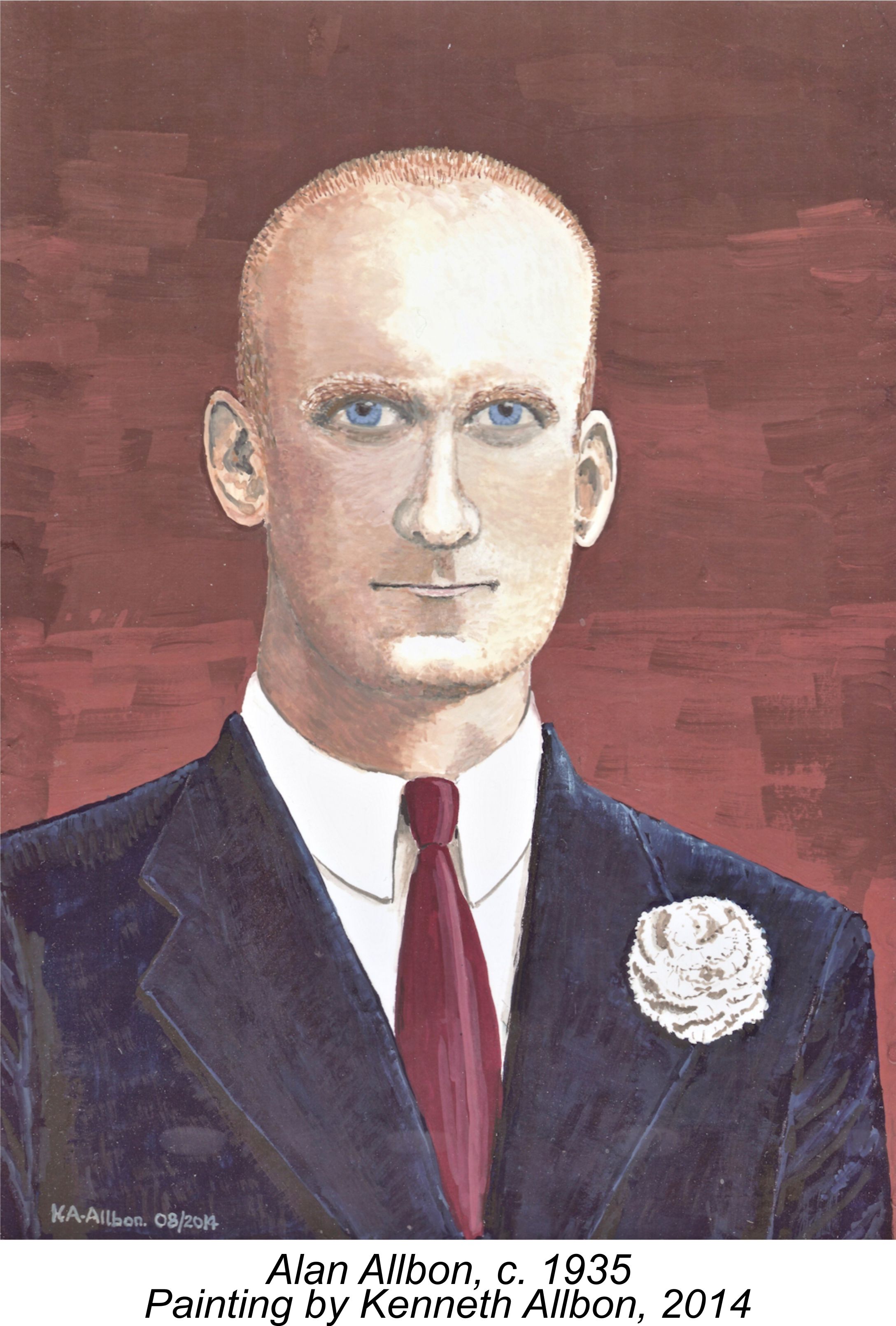 In a separate article on this site I’ve summarized the life and work of
In a separate article on this site I’ve summarized the life and work of 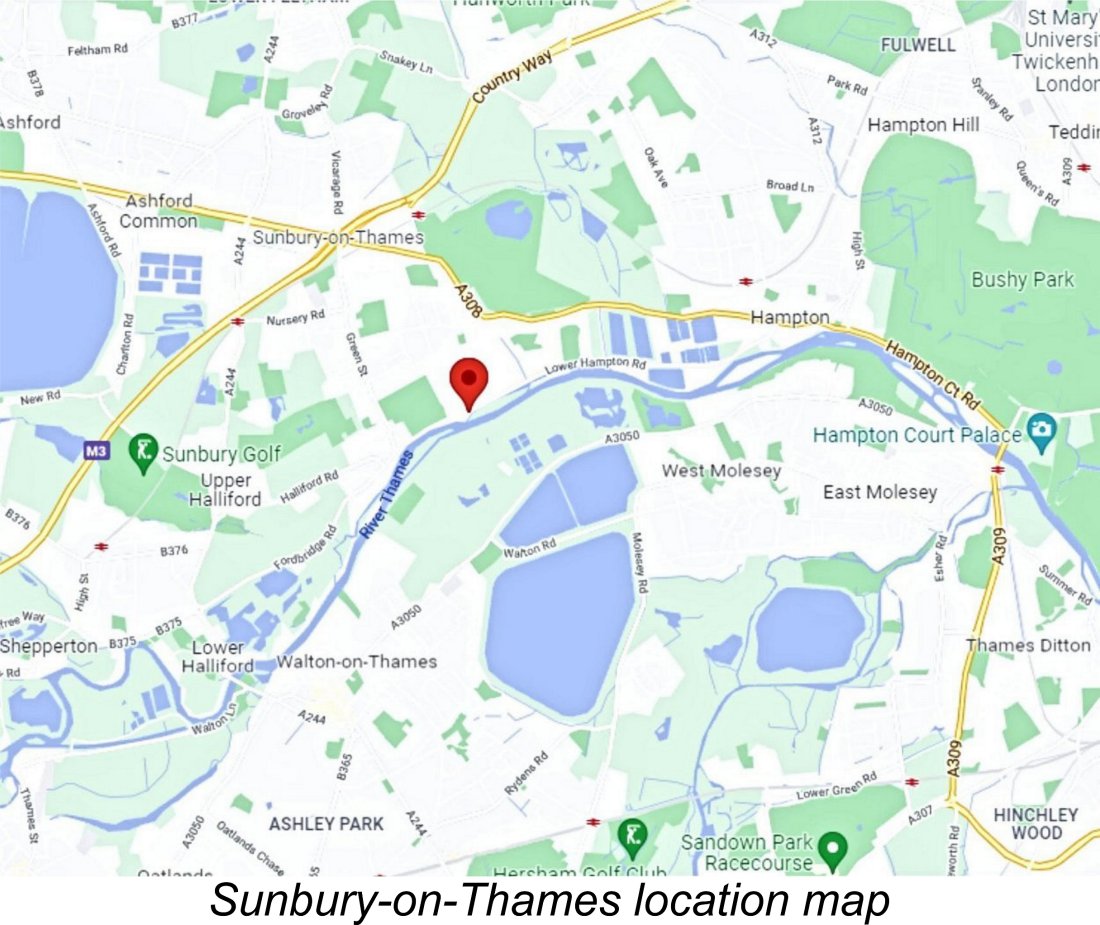 I’ve covered the course of
I’ve covered the course of 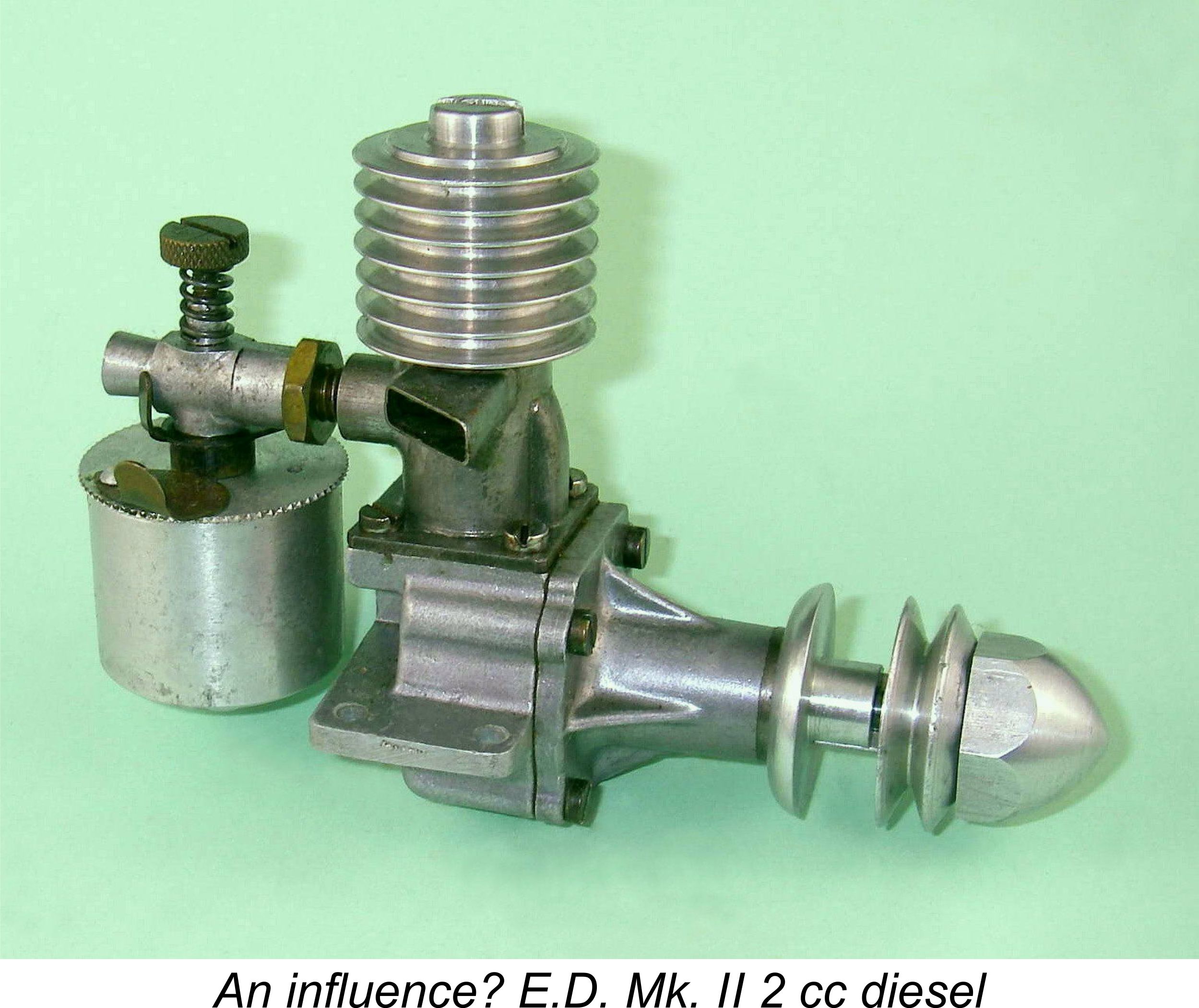 Interestingly enough, Sunbury-on-Thames is located in an area of south-west Greater London in which a number of competing model engine manufacturers conducted their business. Sunbury lies just across the River Thames from the successive haunts of the
Interestingly enough, Sunbury-on-Thames is located in an area of south-west Greater London in which a number of competing model engine manufacturers conducted their business. Sunbury lies just across the River Thames from the successive haunts of the 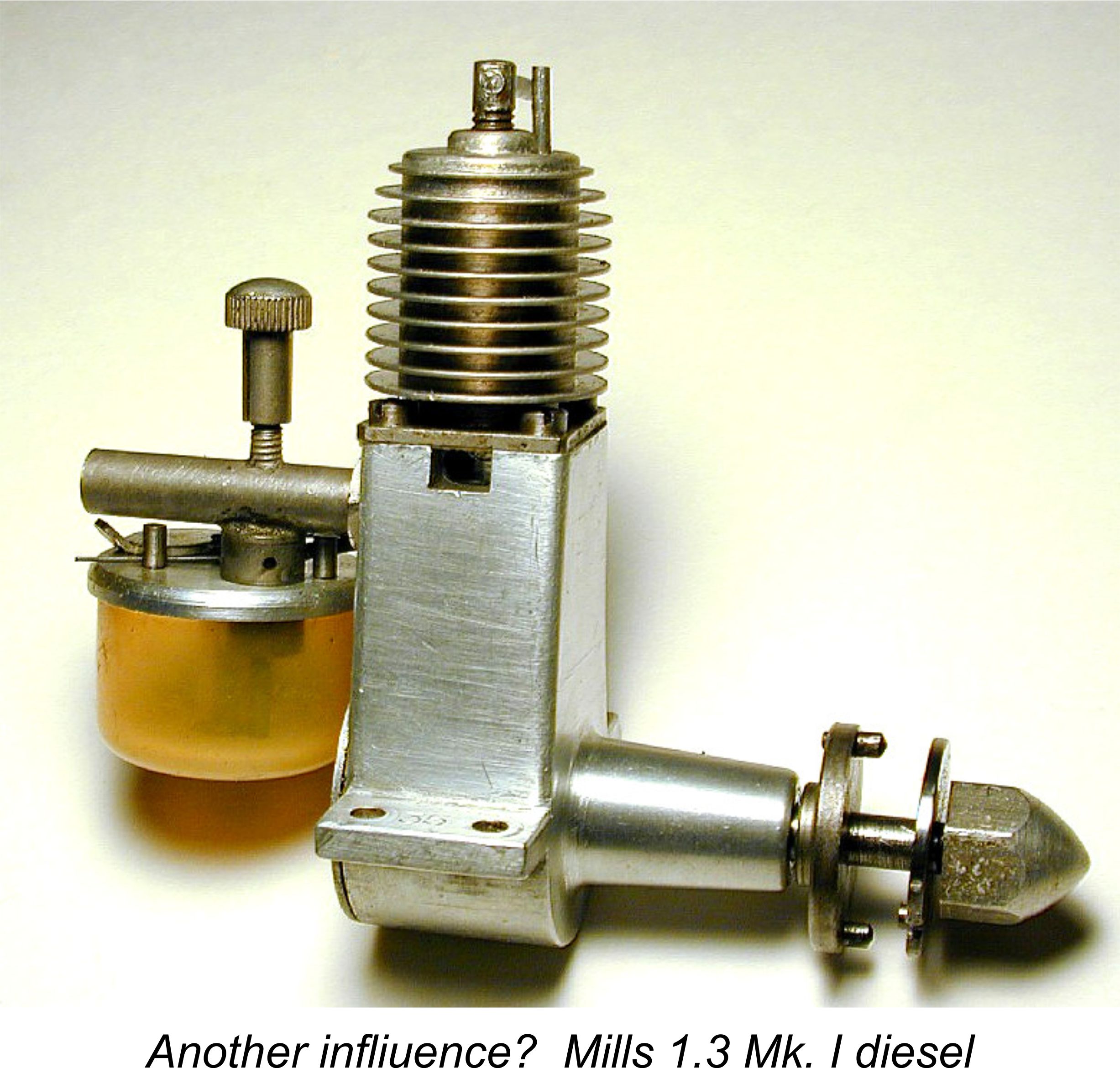 Another factor that must surely have stood Allbon in good stead was his reported ability to get along with other people. Kenneth Allbon objectively characterized his father as a “very nice chap” having an unusually even temperament and a marked ability to get on well with others, even under trying circumstances. As a result, he was always very approachable in addition to being well-liked by his employees and associates. Others who knew Alan personally have independently confirmed Kenneth’s characterization.
Another factor that must surely have stood Allbon in good stead was his reported ability to get along with other people. Kenneth Allbon objectively characterized his father as a “very nice chap” having an unusually even temperament and a marked ability to get on well with others, even under trying circumstances. As a result, he was always very approachable in addition to being well-liked by his employees and associates. Others who knew Alan personally have independently confirmed Kenneth’s characterization.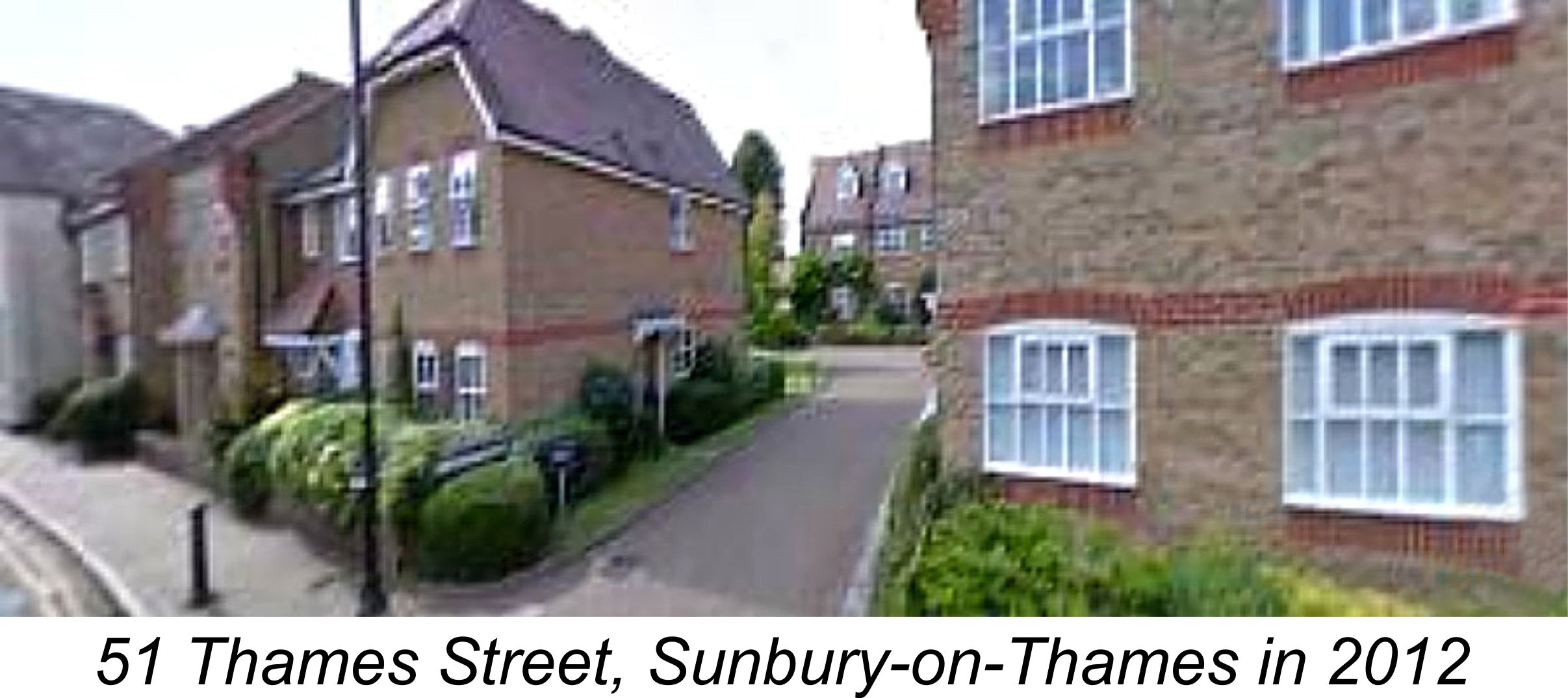 Thames Street has moved well up-market since Allbon's time there. Many of the buildings on the street have since been converted into riverside flats, restaurants or office space. The modest red brick building at 51 Thames Street, which may well be the one formerly occupied by Allbon, was latterly occupied by a branch office of A. A. Telecom Ltd. It appeared to have been re-developed for other uses as of 2021.
Thames Street has moved well up-market since Allbon's time there. Many of the buildings on the street have since been converted into riverside flats, restaurants or office space. The modest red brick building at 51 Thames Street, which may well be the one formerly occupied by Allbon, was latterly occupied by a branch office of A. A. Telecom Ltd. It appeared to have been re-developed for other uses as of 2021.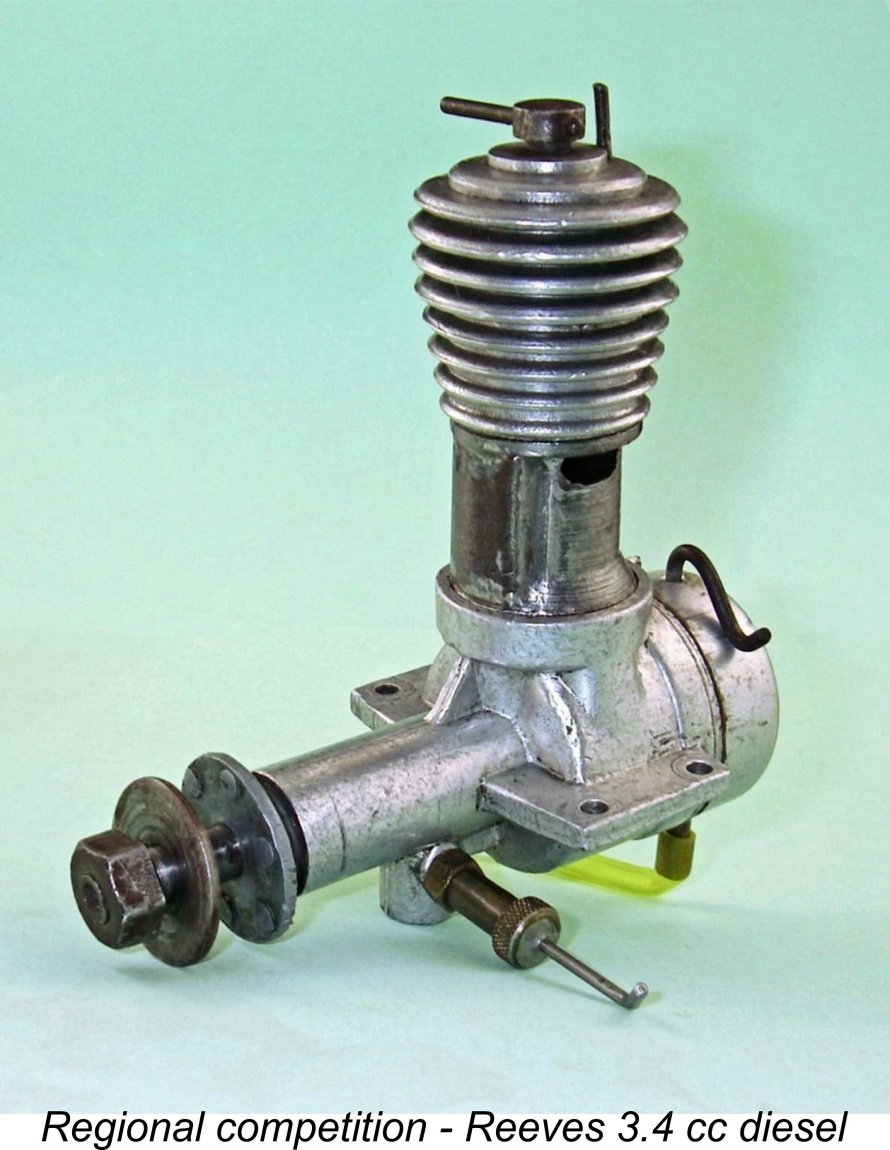 By early 1948, when the first commercial Allbon design appeared, model engine manufacture was a well-established and highly competitive business in Britain. In entering the model engine field, Allbon was going head to head with such nationally-established names as
By early 1948, when the first commercial Allbon design appeared, model engine manufacture was a well-established and highly competitive business in Britain. In entering the model engine field, Allbon was going head to head with such nationally-established names as 
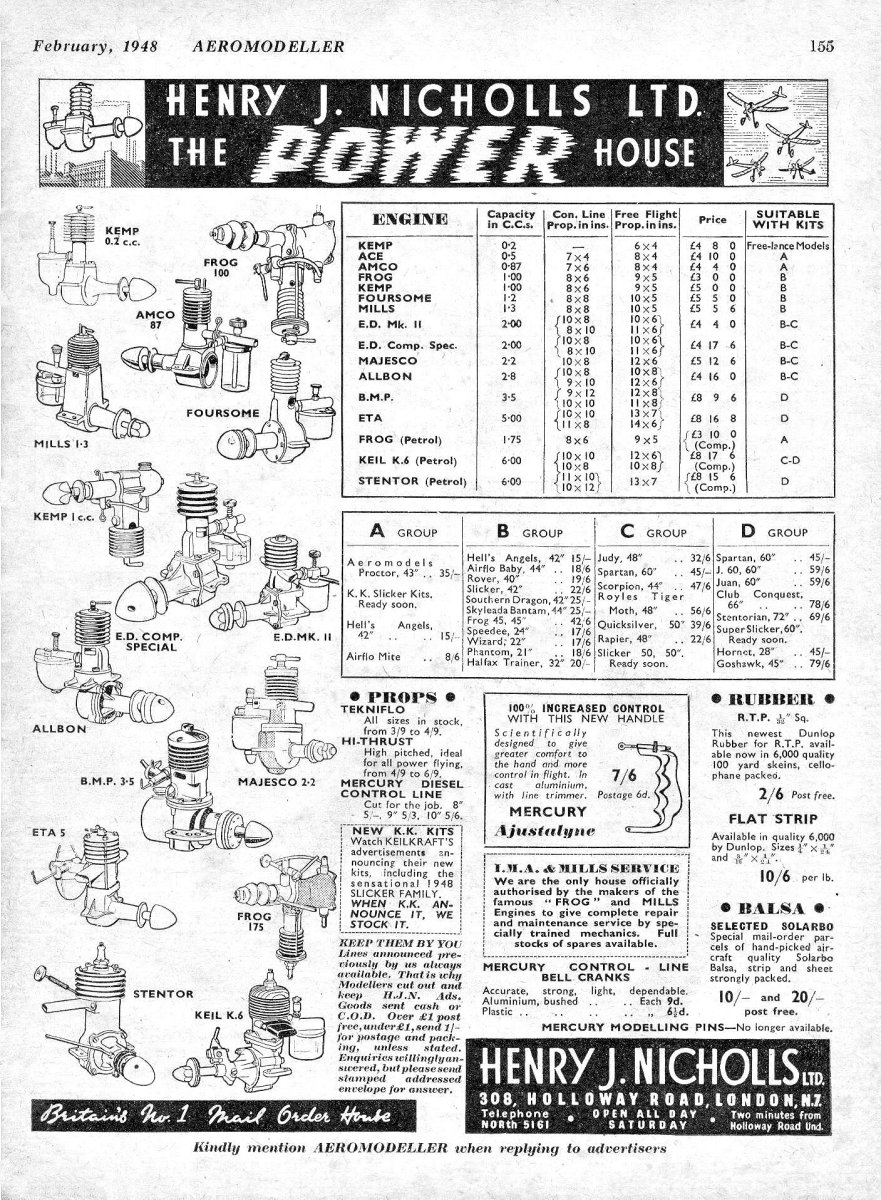
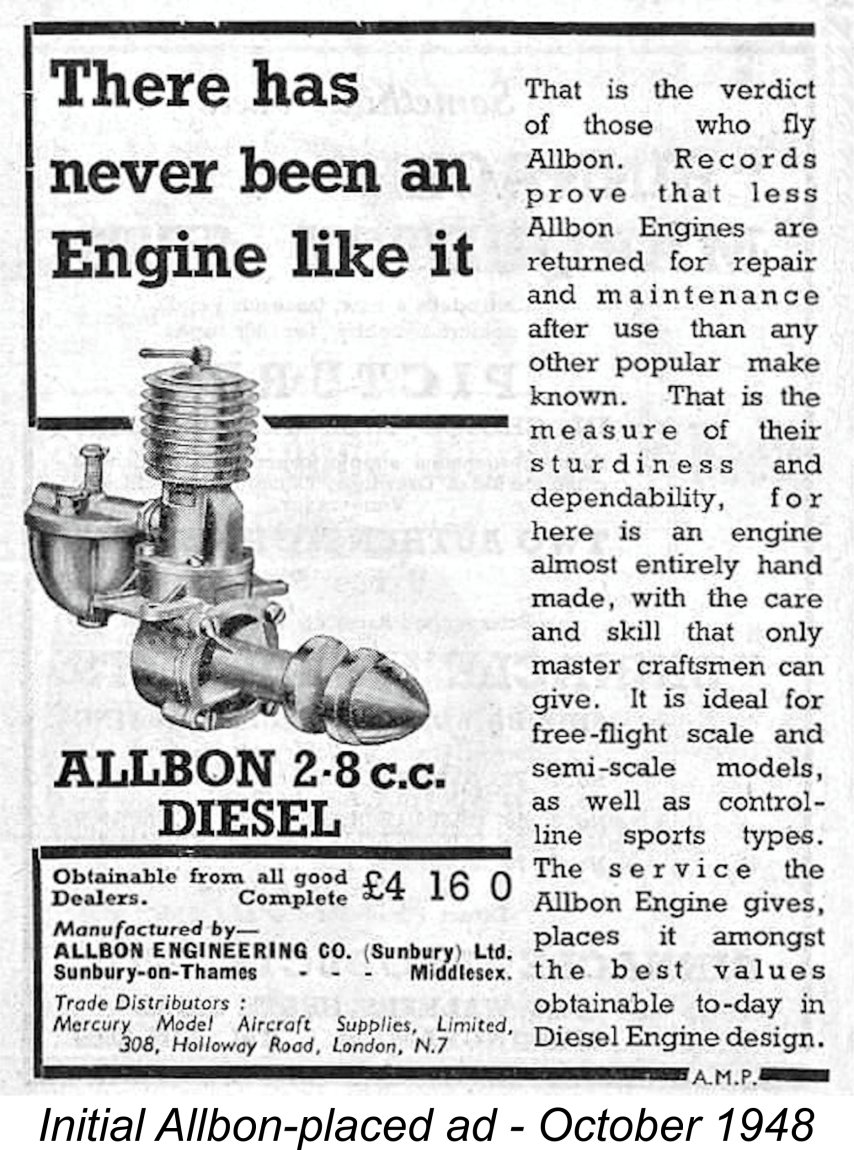
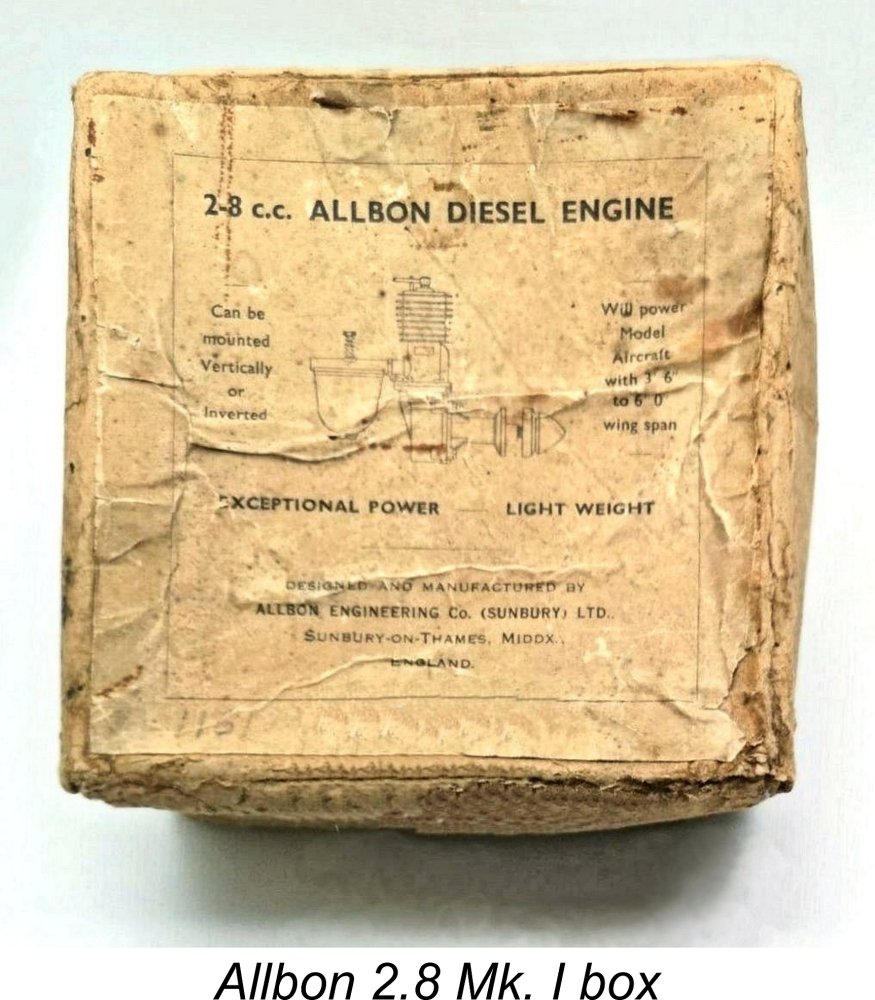
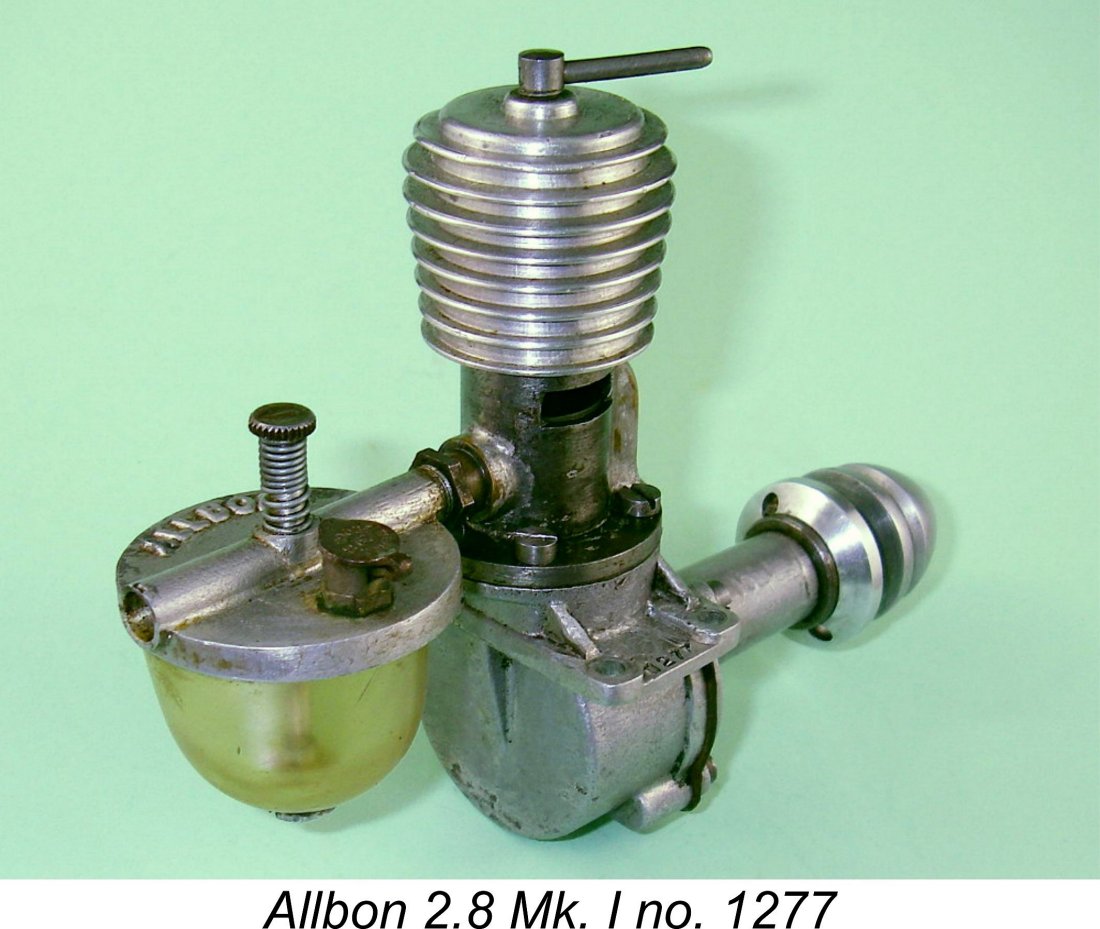
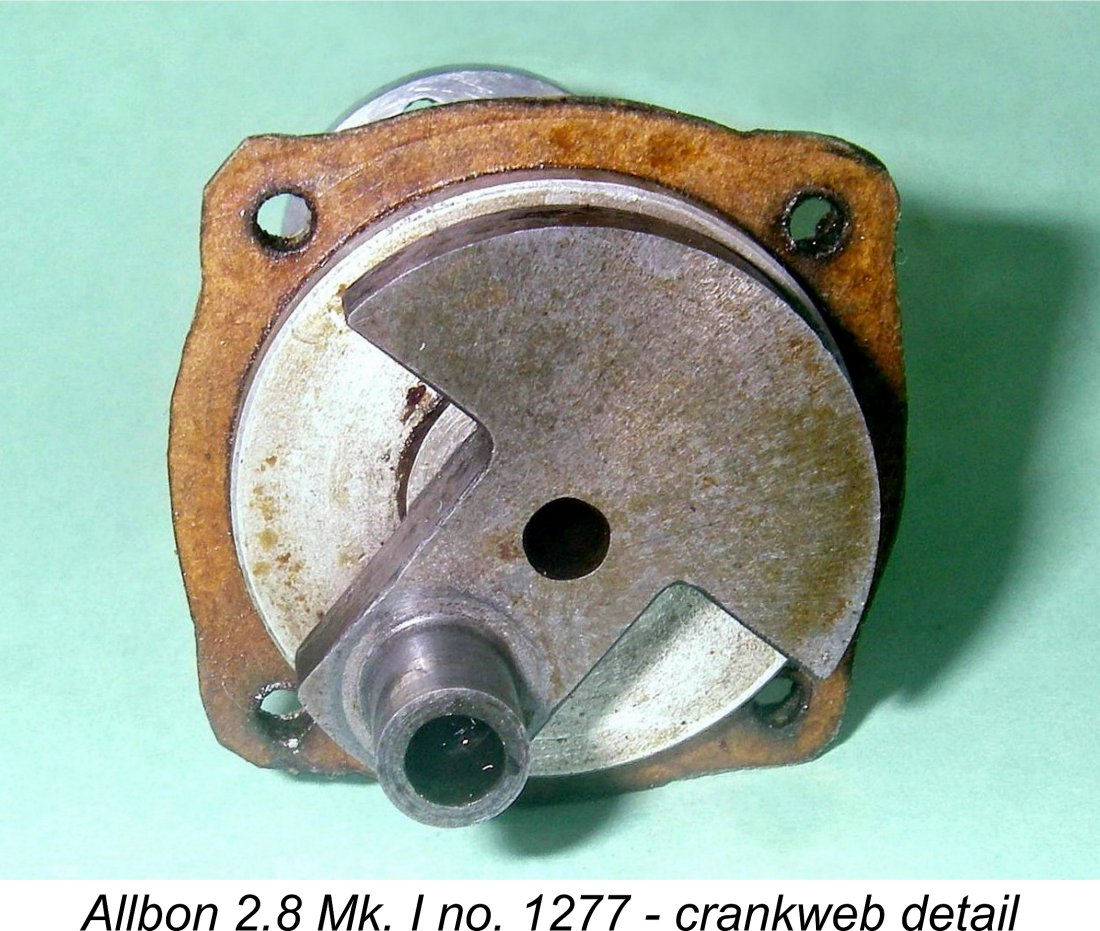 The new model featured nominal bore and stroke measurements of 9/16 in. (0.5625 in./14.287 mm) and 11/16 in. (0.6875 in./17.462 mm) respectively for a displacement of exactly 2.80 cc (0.171 cuin.). The stroke/bore ratio was 1.22 to 1 - a fairly standard figure for the long-stroke sideport diesels of the era. The engine was clearly designed for torque at moderate speeds rather than for all-out power. Weight was 6 ounces exactly (170 gm), complete with tank - a not unreasonable figure for a tank-equipped engine of this displacement.
The new model featured nominal bore and stroke measurements of 9/16 in. (0.5625 in./14.287 mm) and 11/16 in. (0.6875 in./17.462 mm) respectively for a displacement of exactly 2.80 cc (0.171 cuin.). The stroke/bore ratio was 1.22 to 1 - a fairly standard figure for the long-stroke sideport diesels of the era. The engine was clearly designed for torque at moderate speeds rather than for all-out power. Weight was 6 ounces exactly (170 gm), complete with tank - a not unreasonable figure for a tank-equipped engine of this displacement.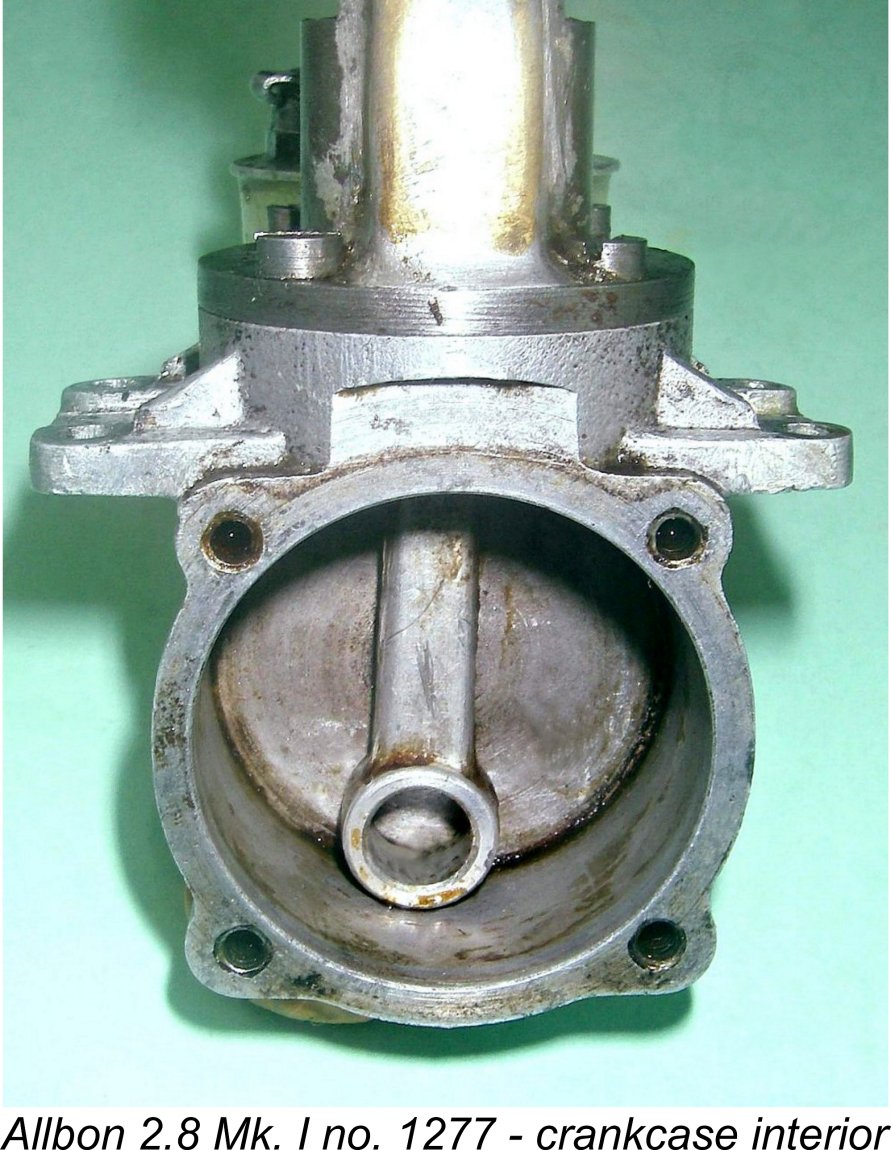 The crankcase also bore some similarity to that of the competing E.D. models, having an integrally-cast backplate. However, it was far more lightly constructed. In particular, the mounting lugs appear to be very fragile indeed, especially for an engine of this weight and displacement. Frankly, I wouldn't give much for the chances of the lugs surviving a really hard crash ........... those used on the smaller E.D. models were far more appropriately dimensioned in my personal opinion. Alan Allbon seems to have dropped the ball on this aspect of the design.
The crankcase also bore some similarity to that of the competing E.D. models, having an integrally-cast backplate. However, it was far more lightly constructed. In particular, the mounting lugs appear to be very fragile indeed, especially for an engine of this weight and displacement. Frankly, I wouldn't give much for the chances of the lugs surviving a really hard crash ........... those used on the smaller E.D. models were far more appropriately dimensioned in my personal opinion. Alan Allbon seems to have dropped the ball on this aspect of the design.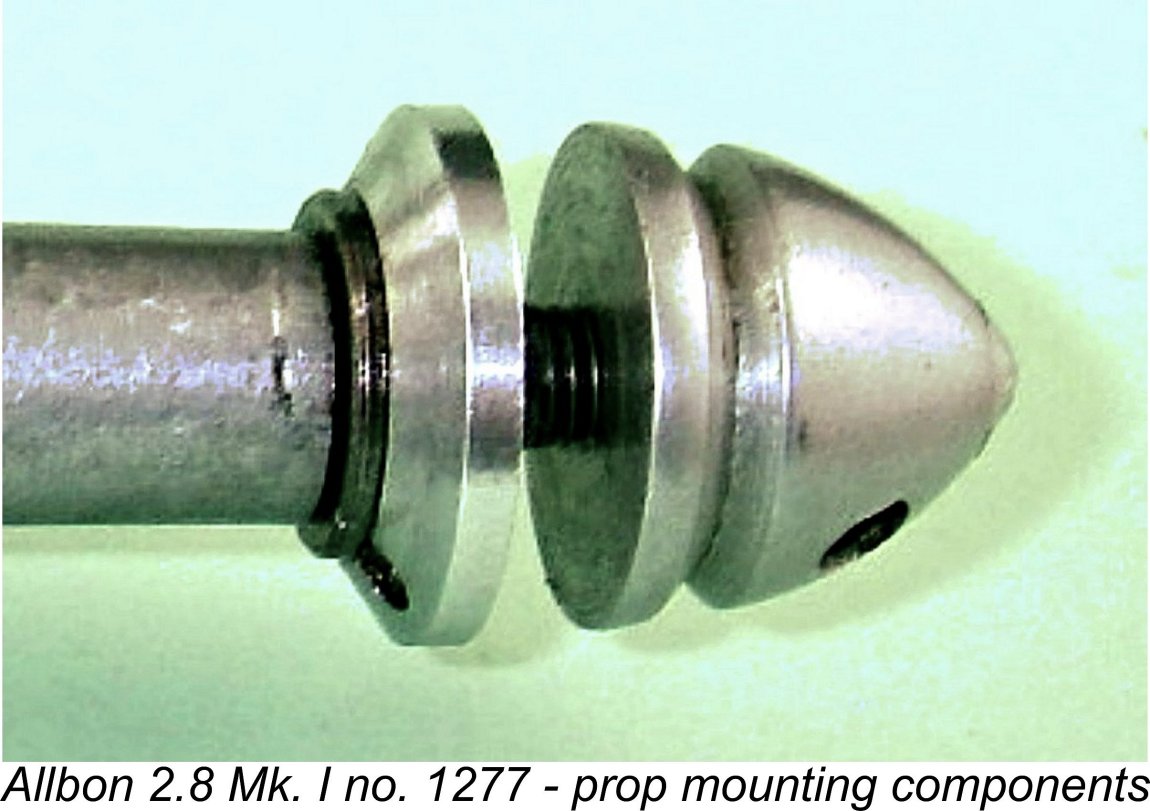 Indeed, the direct similarities between the E.D. and Allbon designs ended at this point. The prop attachment arrangements were quite different, the Allbon using a plain one-piece prop driver in combination with an aluminium alloy spinner nut mating with a ¼-26 BSF thread. The Allbon's prop driver was very sensibly backed up by a steel thrust washer both to limit end float and to prevent scuffing between the alloy faces of the driver and main bearing housing.
Indeed, the direct similarities between the E.D. and Allbon designs ended at this point. The prop attachment arrangements were quite different, the Allbon using a plain one-piece prop driver in combination with an aluminium alloy spinner nut mating with a ¼-26 BSF thread. The Allbon's prop driver was very sensibly backed up by a steel thrust washer both to limit end float and to prevent scuffing between the alloy faces of the driver and main bearing housing. 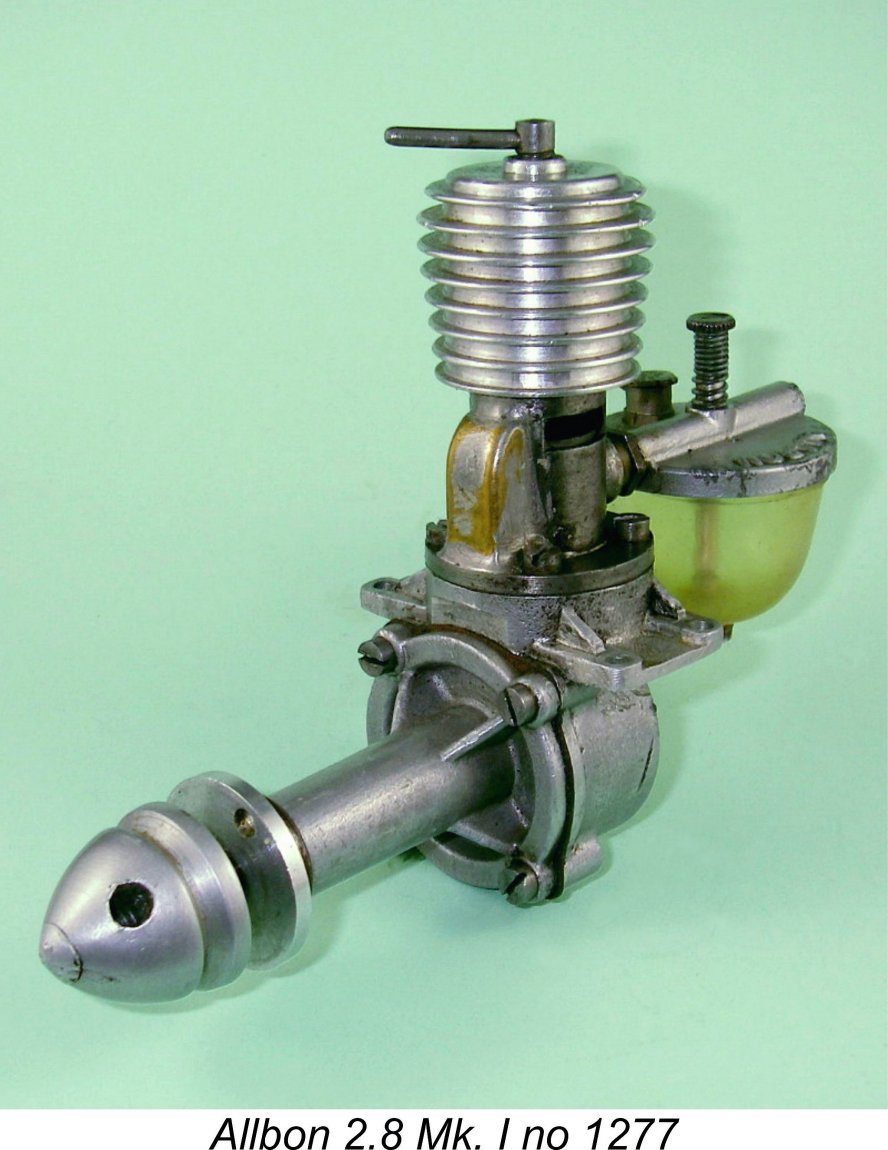 While this was a very neat approach to the mounting of the conrod small end in the piston, it did have two downsides. One was the possibility of the screw coming loose, which could have rather unfortunate results! The consequent necessity of tightening the screw really hard to begin with might also make loosening of the screw to permit removal of the carrier for conrod replacement somewhat problematic, particularly insofar as it might cause piston distortion when re-tightened. It would also be necessary to take appropriate precautions against twisting of the conrod.
While this was a very neat approach to the mounting of the conrod small end in the piston, it did have two downsides. One was the possibility of the screw coming loose, which could have rather unfortunate results! The consequent necessity of tightening the screw really hard to begin with might also make loosening of the screw to permit removal of the carrier for conrod replacement somewhat problematic, particularly insofar as it might cause piston distortion when re-tightened. It would also be necessary to take appropriate precautions against twisting of the conrod. 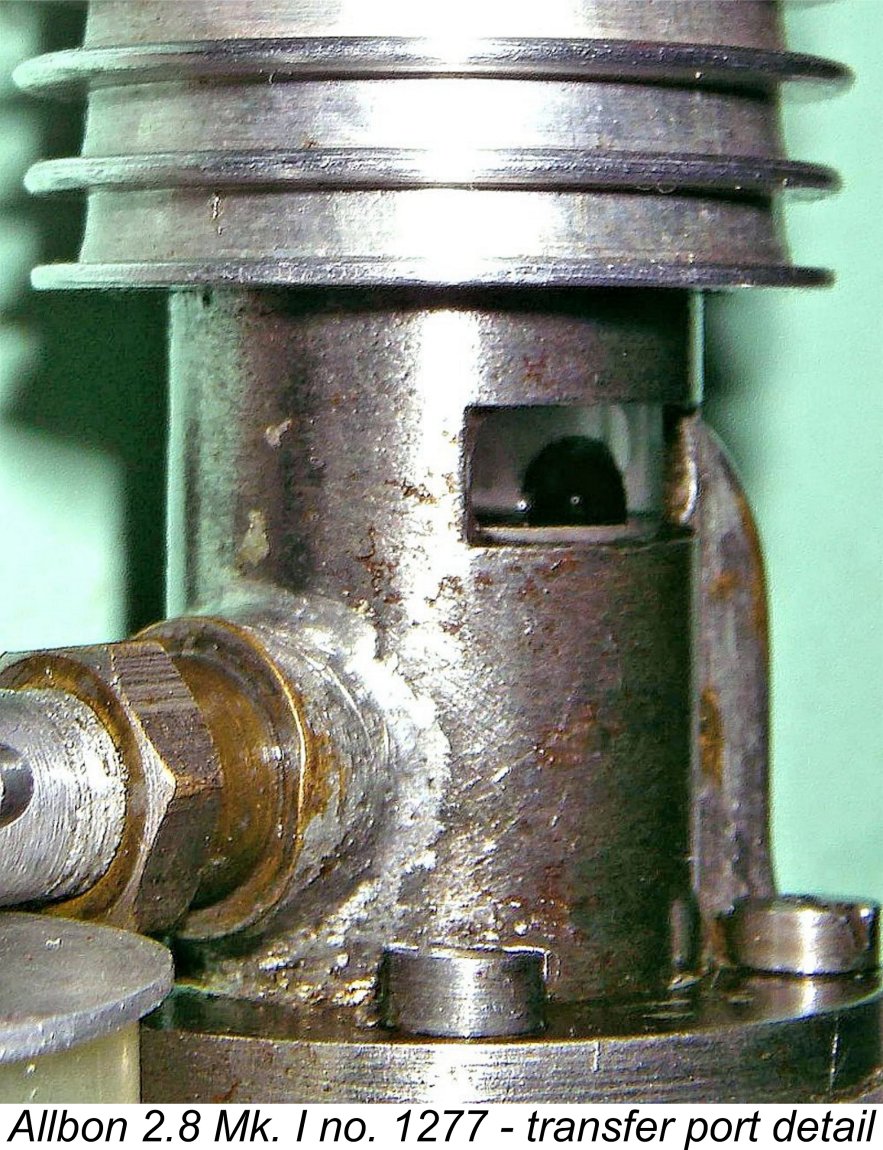 I noted earlier that the soldered-on bypass passage was formed from brass sheet, exactly as in the E.D. designs. This bypass passage was fed at its base by a pair of 5/32 (0.156) in. dia. holes drilled vertically through the cylinder location flange. These holes were supplied with mixture by means of a channel formed at the front of the main crankcase casting immediately below the cylinder mounting flange. Gas access to the bypass entry point was thus relatively unimpeded.
I noted earlier that the soldered-on bypass passage was formed from brass sheet, exactly as in the E.D. designs. This bypass passage was fed at its base by a pair of 5/32 (0.156) in. dia. holes drilled vertically through the cylinder location flange. These holes were supplied with mixture by means of a channel formed at the front of the main crankcase casting immediately below the cylinder mounting flange. Gas access to the bypass entry point was thus relatively unimpeded.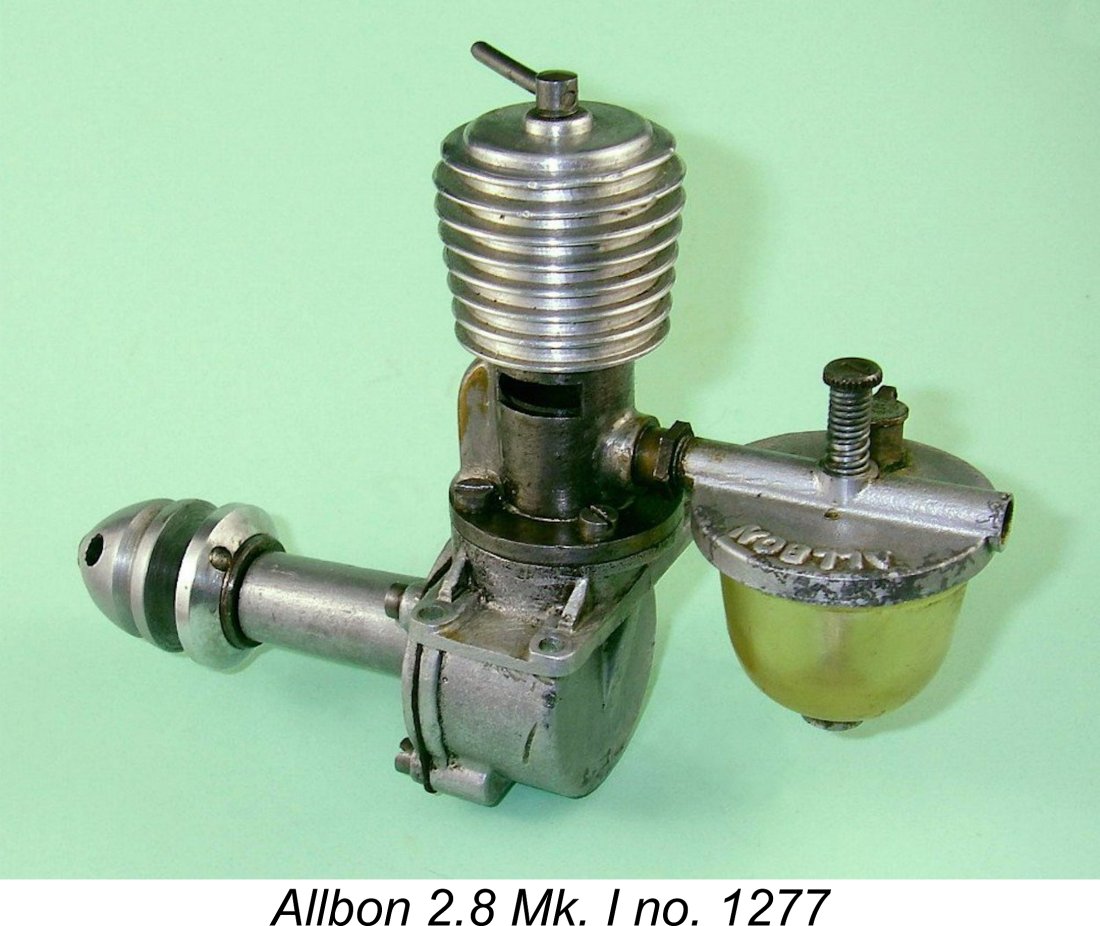 The engine was completed by the attachment of a very neat combined carburettor/fuel tank assembly. The carburettor body was a casting to which the tank was secured using the integrally-cast tank top as a mounting. Somewhat unusually by the standards of the day, no cut-out was fitted. The needle itself was externally threaded 6BA and was very effectively tensioned by a coil spring. The tank was of bowl form, with ample capacity for free-flight purposes.
The engine was completed by the attachment of a very neat combined carburettor/fuel tank assembly. The carburettor body was a casting to which the tank was secured using the integrally-cast tank top as a mounting. Somewhat unusually by the standards of the day, no cut-out was fitted. The needle itself was externally threaded 6BA and was very effectively tensioned by a coil spring. The tank was of bowl form, with ample capacity for free-flight purposes.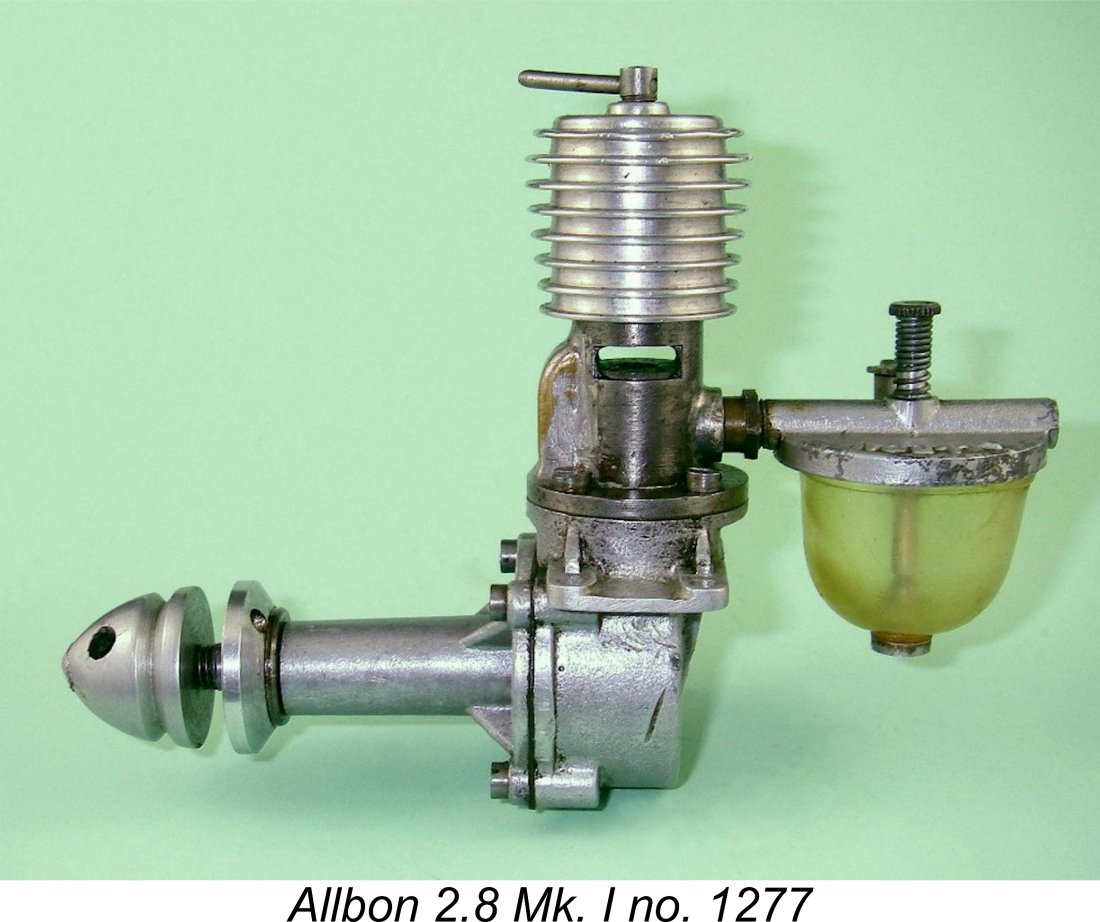 The Allbon 2.8 Mk I can best be summed up as a well-made engine of generally sound but perhaps rather uninspiring design, also appearing somewhat fragile in terms of crash resistance. It's clear that Allbon had yet to find his own feet as a model engine designer, relying at this stage to a large extent upon insights gained through examination of the products of other manufacturers. Still, the Allbon 2.8 was undoubtedly a very useable unit which served its purpose in getting the Allbon Engineering model engine manufacturing venture off to a good start.
The Allbon 2.8 Mk I can best be summed up as a well-made engine of generally sound but perhaps rather uninspiring design, also appearing somewhat fragile in terms of crash resistance. It's clear that Allbon had yet to find his own feet as a model engine designer, relying at this stage to a large extent upon insights gained through examination of the products of other manufacturers. Still, the Allbon 2.8 was undoubtedly a very useable unit which served its purpose in getting the Allbon Engineering model engine manufacturing venture off to a good start.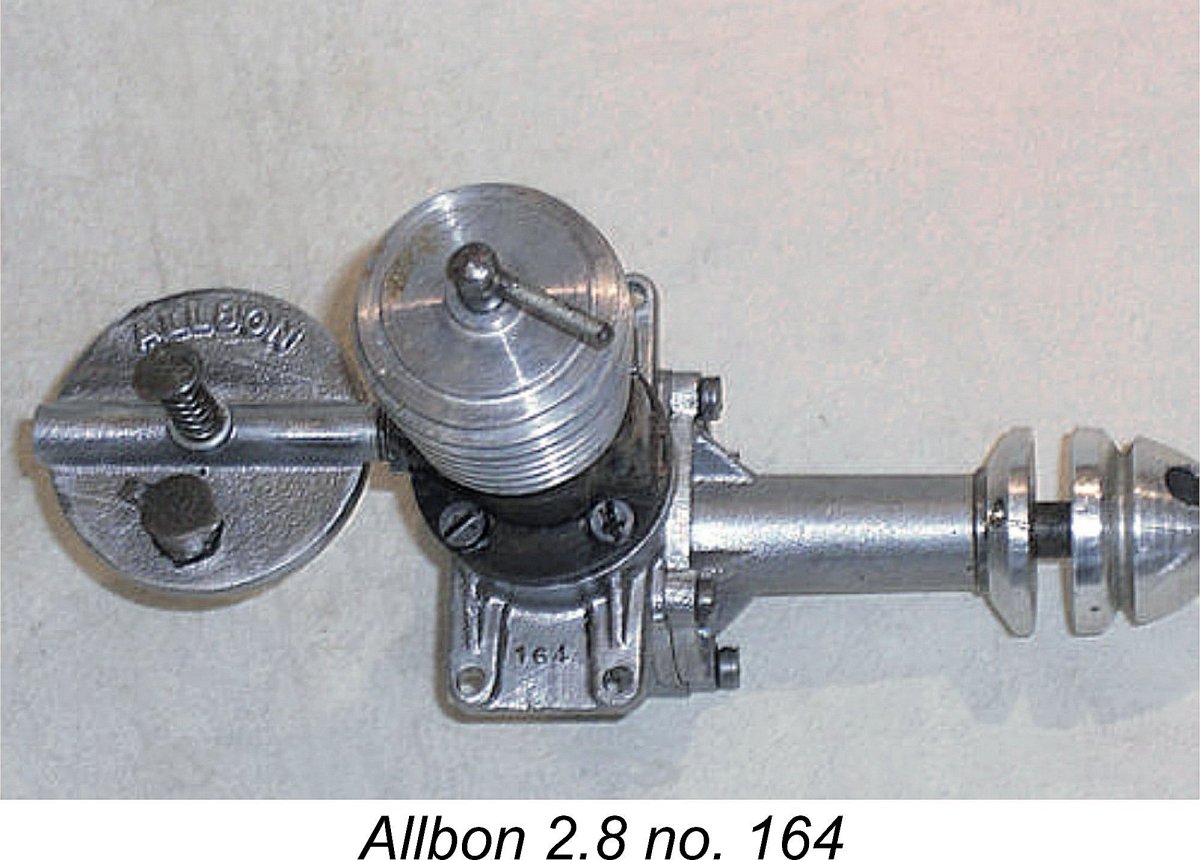
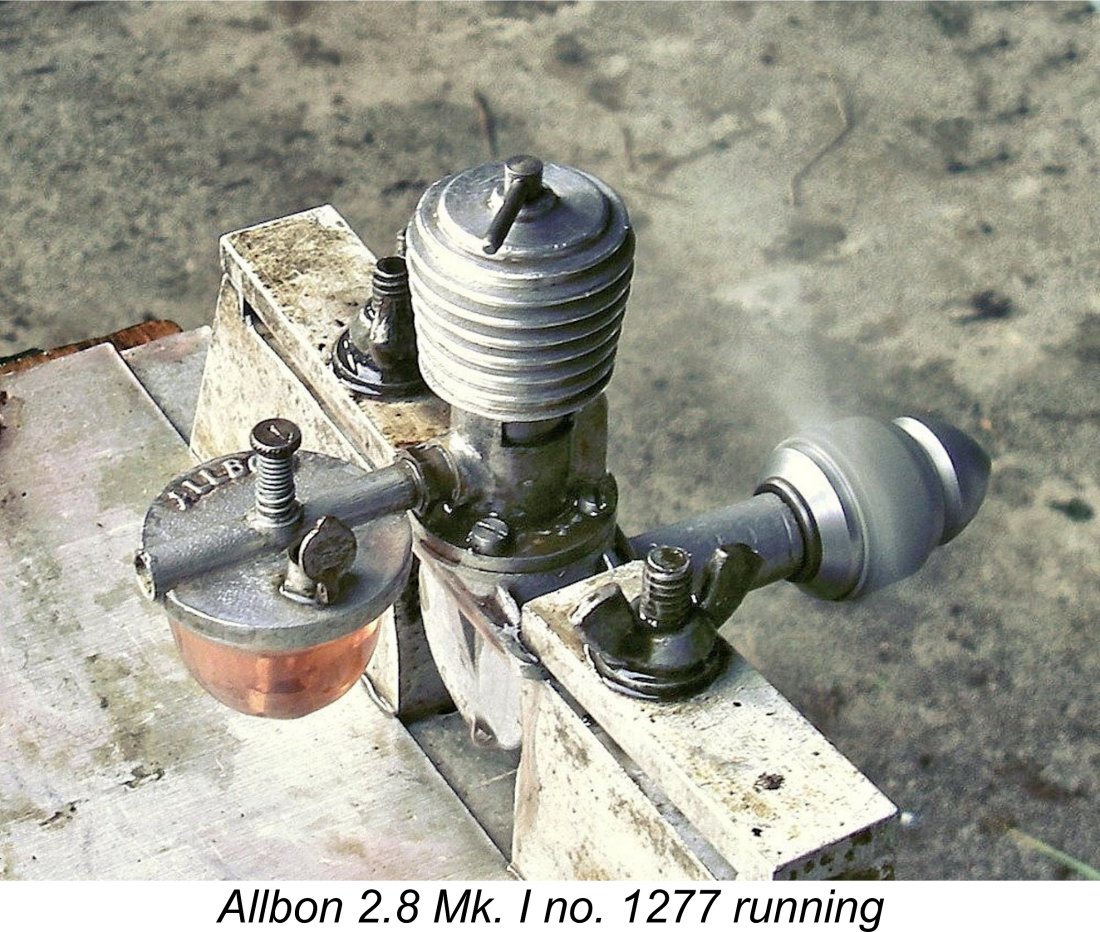 Accordingly, I'll have to do my best using my own resources. My own previously-illustrated example of the 2.8 Mk. I bearing the serial number 1277 had been tested earlier, but was re-tested to provide background for this updated article. This example is in excellent mechanical and cosmetic condition, being completely original in all respects. The fuel used was my usual "early diesel" brew of 35% ether, 35% kerosene and 30% SAE 60 mineral oil.
Accordingly, I'll have to do my best using my own resources. My own previously-illustrated example of the 2.8 Mk. I bearing the serial number 1277 had been tested earlier, but was re-tested to provide background for this updated article. This example is in excellent mechanical and cosmetic condition, being completely original in all respects. The fuel used was my usual "early diesel" brew of 35% ether, 35% kerosene and 30% SAE 60 mineral oil. 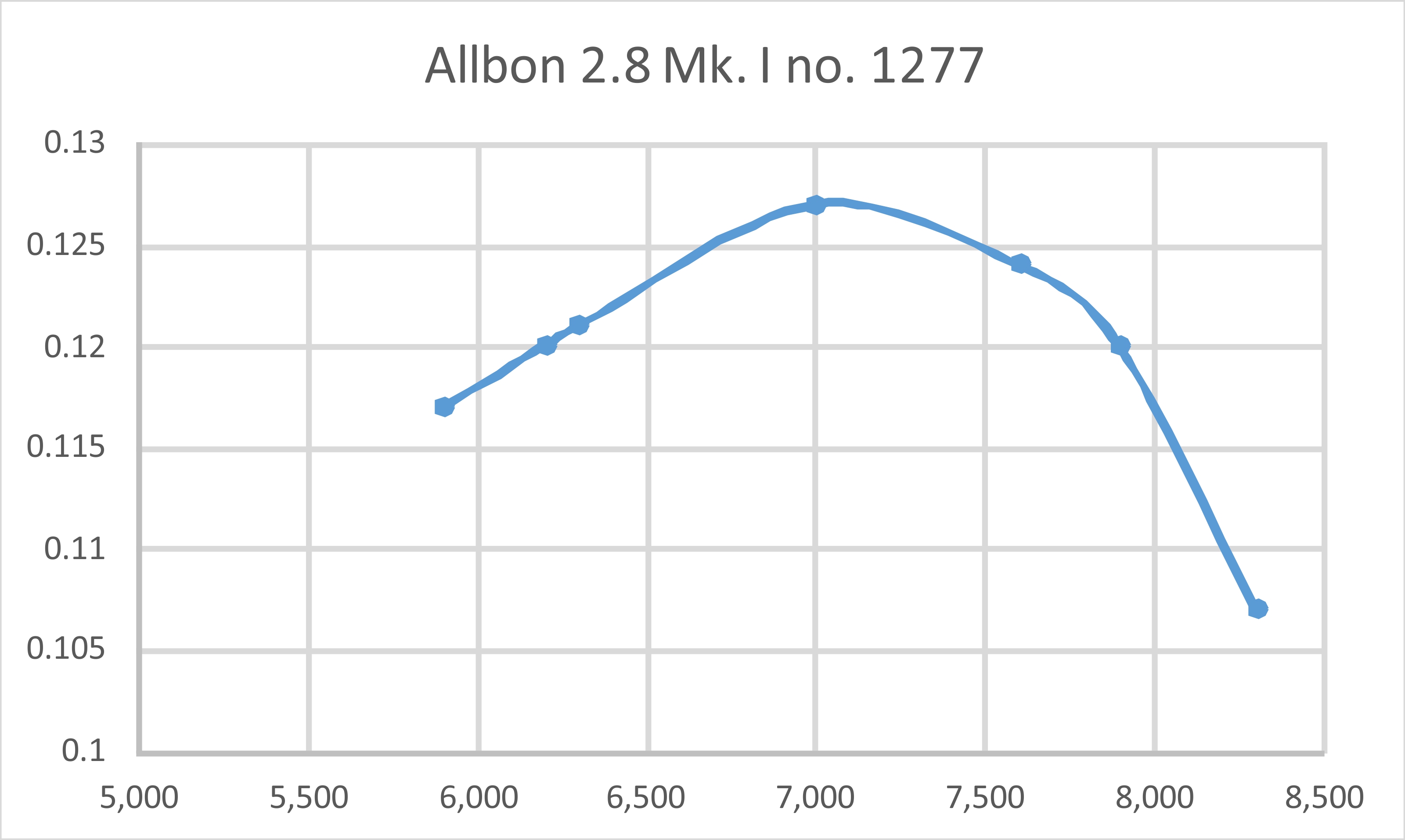
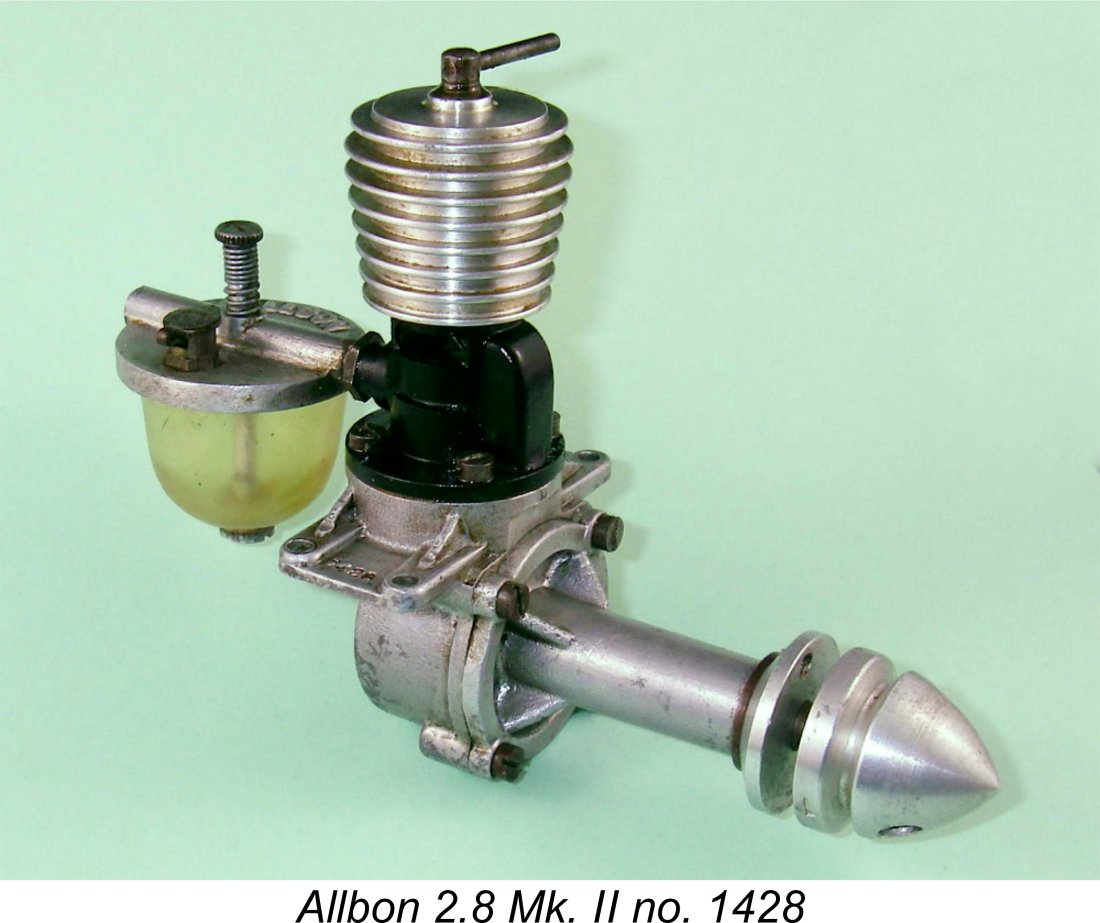 I noted previously that production of the Allbon 2.8 Mk. I appears to have continued up to October 1948. The highest serial number yet reported for a Mk. I model of the engine is 1277 stamped on my own unit.
I noted previously that production of the Allbon 2.8 Mk. I appears to have continued up to October 1948. The highest serial number yet reported for a Mk. I model of the engine is 1277 stamped on my own unit.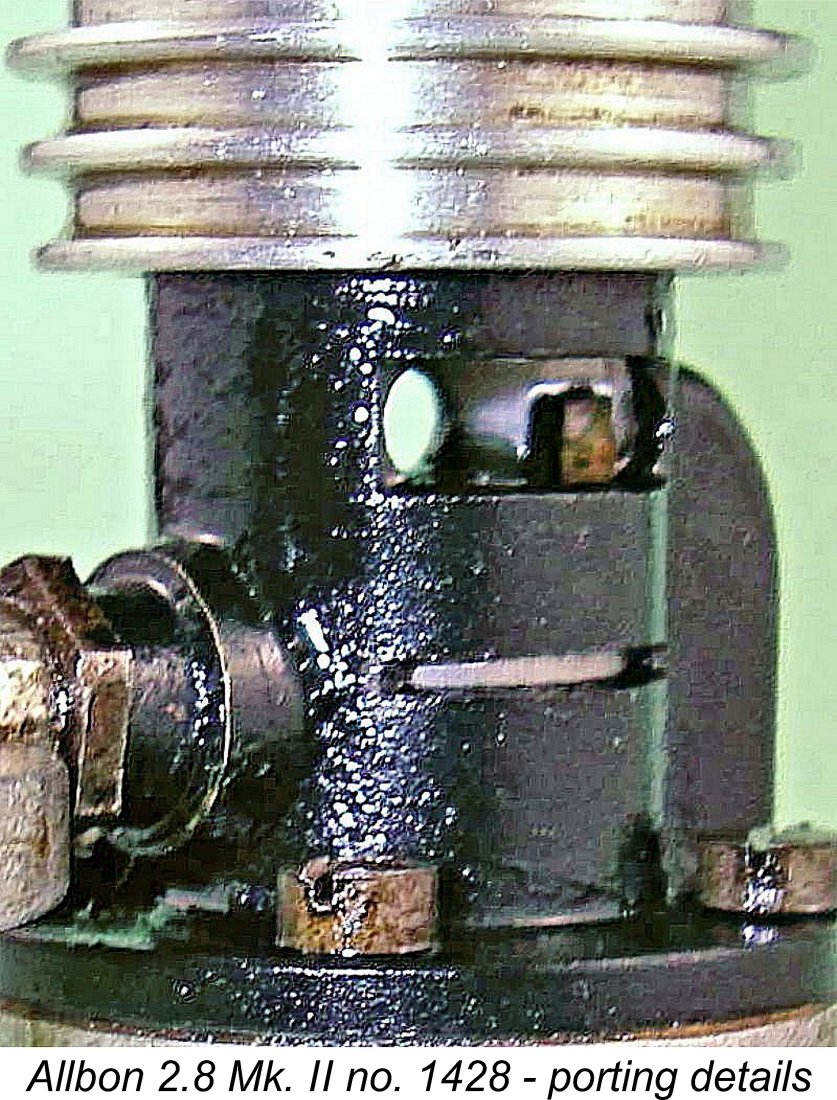 Consequently, the Mk. II version of the Allbon 2.8 featured a pair of slots beneath the exhaust ports which were opened by the piston skirt near top dead centre to give sub-piston induction. The same effect could theoretically have been achieved very simply by making the exhaust ports deeper, as E.D had done with their 2 cc model to produce the Comp Special. However, the length of the piston skirt in the 2.8 led Allbon to the inescapable conclusion that this would remove far too much of the piston support area from the cylinder wall. Looking at the accompanying image, one can only agree with him! Such a move would have required a substantial shortening of the piston skirt along with a matching upward relocation of the induction port.
Consequently, the Mk. II version of the Allbon 2.8 featured a pair of slots beneath the exhaust ports which were opened by the piston skirt near top dead centre to give sub-piston induction. The same effect could theoretically have been achieved very simply by making the exhaust ports deeper, as E.D had done with their 2 cc model to produce the Comp Special. However, the length of the piston skirt in the 2.8 led Allbon to the inescapable conclusion that this would remove far too much of the piston support area from the cylinder wall. Looking at the accompanying image, one can only agree with him! Such a move would have required a substantial shortening of the piston skirt along with a matching upward relocation of the induction port.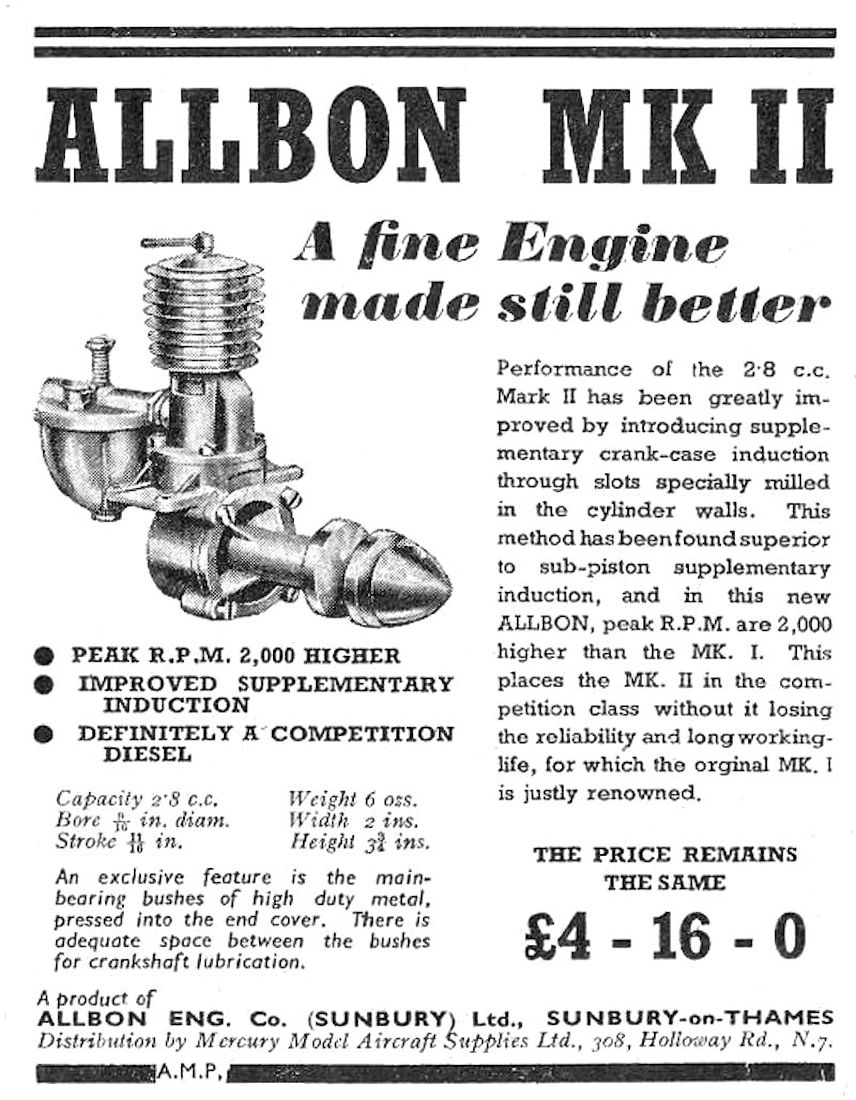 These were actually the only functional changes to the design - in all other respects, the Mk. II was identical to the Mk. I. The cylinder of the Mk. II was painted black to distinguish it from the Mk. I at a glance, but this had no effect on performance. However, the same could not be said for the sub-piston induction and transfer port reconfiguration! The manufacturers specifically drew attention to the sub-piston induction in their advertising for the Mk. II, claiming rather optimistically that it extended the peak speed range by 2,000 rpm. The advertising also claimed that the revised model was "definitely a competition diesel", a statement which implies that this accolade had not been widely accorded to the original design!
These were actually the only functional changes to the design - in all other respects, the Mk. II was identical to the Mk. I. The cylinder of the Mk. II was painted black to distinguish it from the Mk. I at a glance, but this had no effect on performance. However, the same could not be said for the sub-piston induction and transfer port reconfiguration! The manufacturers specifically drew attention to the sub-piston induction in their advertising for the Mk. II, claiming rather optimistically that it extended the peak speed range by 2,000 rpm. The advertising also claimed that the revised model was "definitely a competition diesel", a statement which implies that this accolade had not been widely accorded to the original design!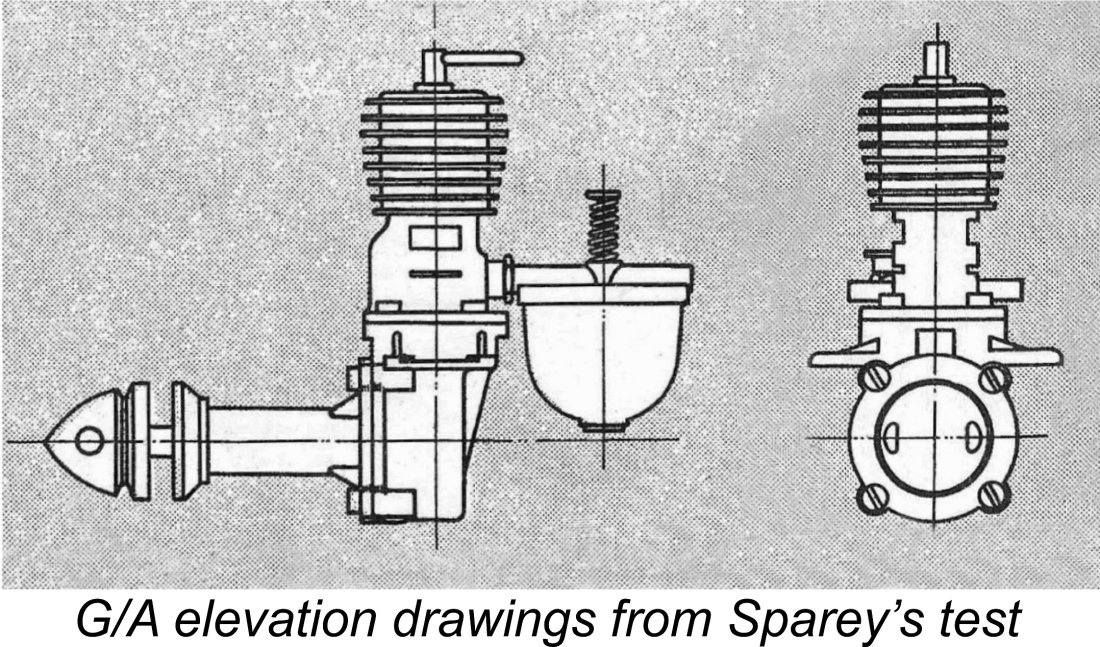 this feature - the two sub-piston induction slots are clearly depicted on those drawings. The absence of comment makes it appear likely that Sparey was unaware that there had been an earlier version of the engine.
this feature - the two sub-piston induction slots are clearly depicted on those drawings. The absence of comment makes it appear likely that Sparey was unaware that there had been an earlier version of the engine.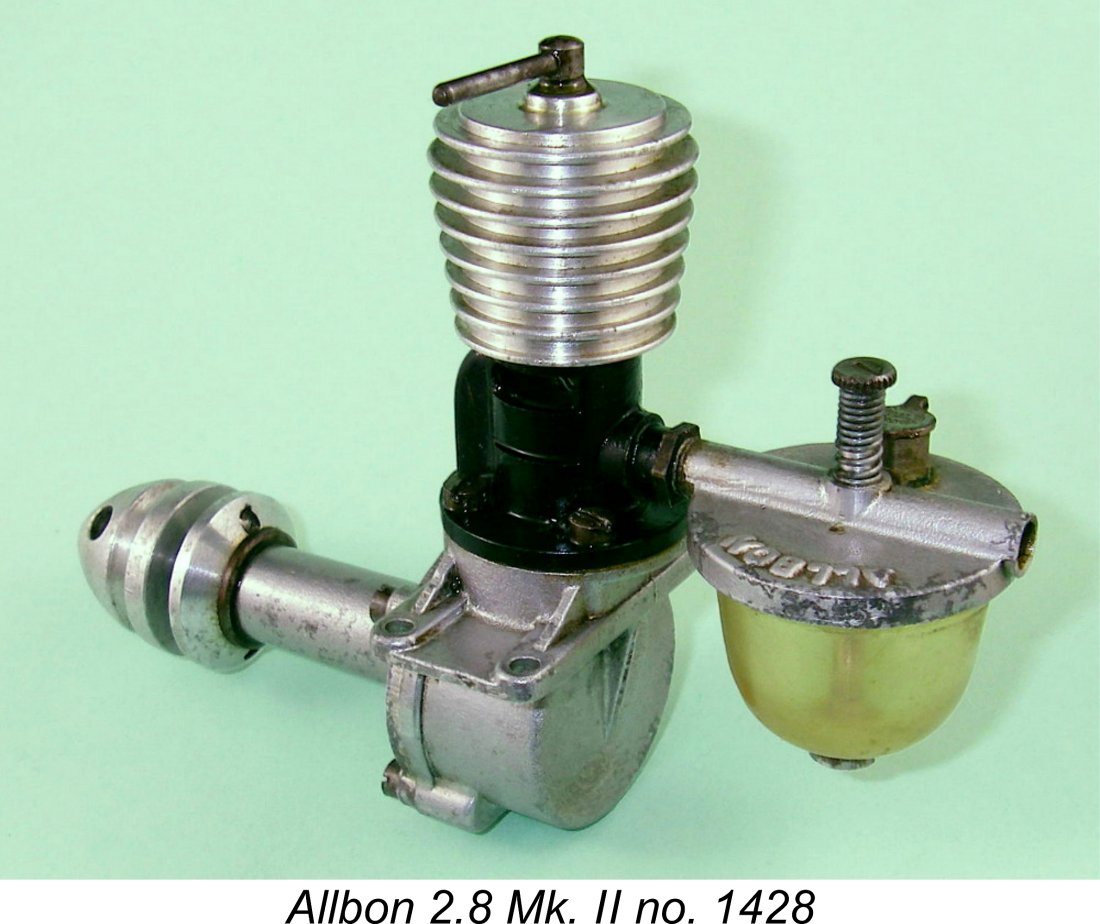 If this was Allbon's strategy, it was certainly effective - Sparey's report was entirely favourable. He noted that "good starting was a feature of the engine" and reported that it ran "extremely well over a fairly wide range of speeds". He also commented upon the engine's excellent response to the controls, together with a general absence of "fussiness". He characterized the measured peak output of 0.144 BHP @ 6,500 rpm as "exceptional for an engine of this capacity". This is a substantially higher output than that obtained in my own testing of the Mk. I version as reported above, although we might reasonably expect this given the absence of sub-piston induction in the tested Mk. I example.
If this was Allbon's strategy, it was certainly effective - Sparey's report was entirely favourable. He noted that "good starting was a feature of the engine" and reported that it ran "extremely well over a fairly wide range of speeds". He also commented upon the engine's excellent response to the controls, together with a general absence of "fussiness". He characterized the measured peak output of 0.144 BHP @ 6,500 rpm as "exceptional for an engine of this capacity". This is a substantially higher output than that obtained in my own testing of the Mk. I version as reported above, although we might reasonably expect this given the absence of sub-piston induction in the tested Mk. I example. 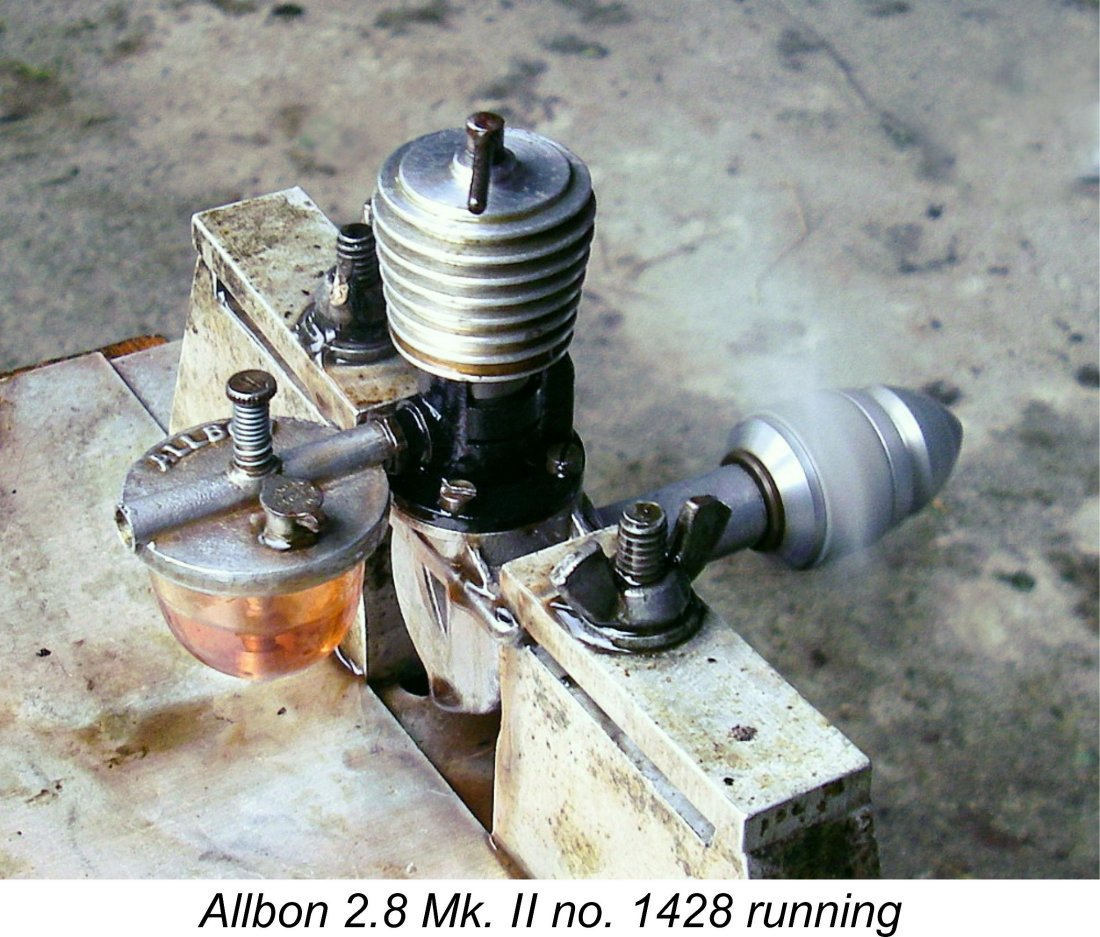 First up was previously-tested Mk. I engine number 1277. The engine proved just as easy to start and adjust as before, making the testing a really painless and enjoyable process. The data obtained have been presented earlier.
First up was previously-tested Mk. I engine number 1277. The engine proved just as easy to start and adjust as before, making the testing a really painless and enjoyable process. The data obtained have been presented earlier. 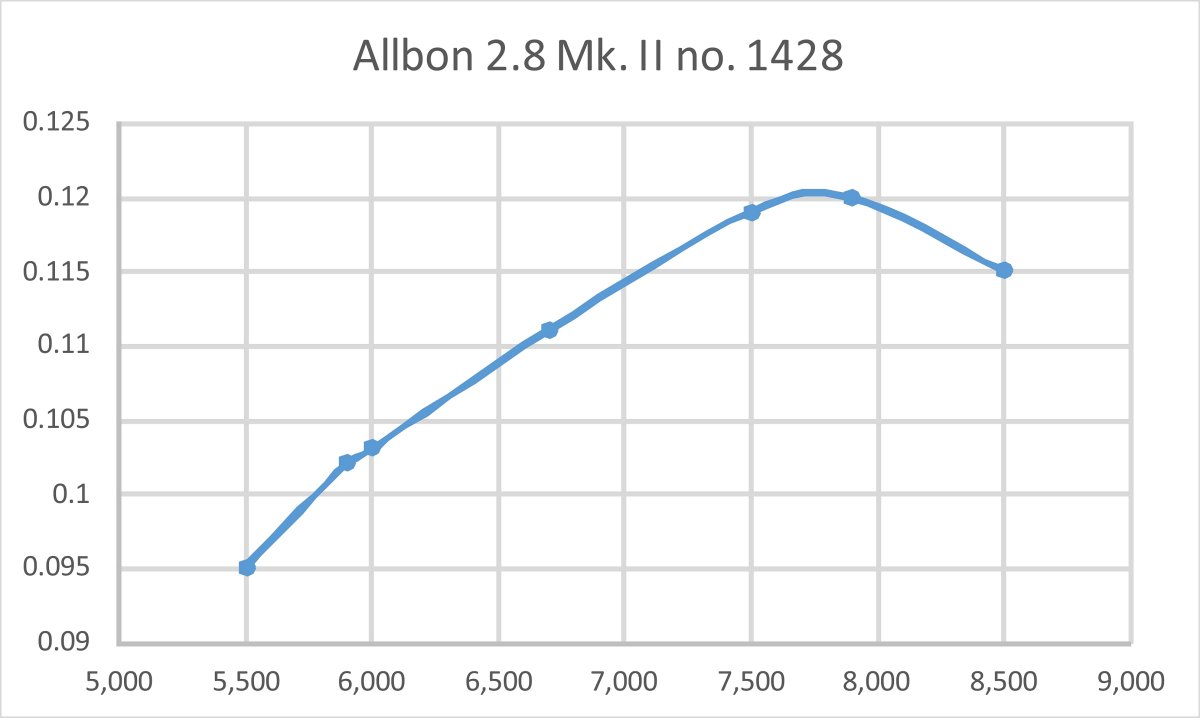
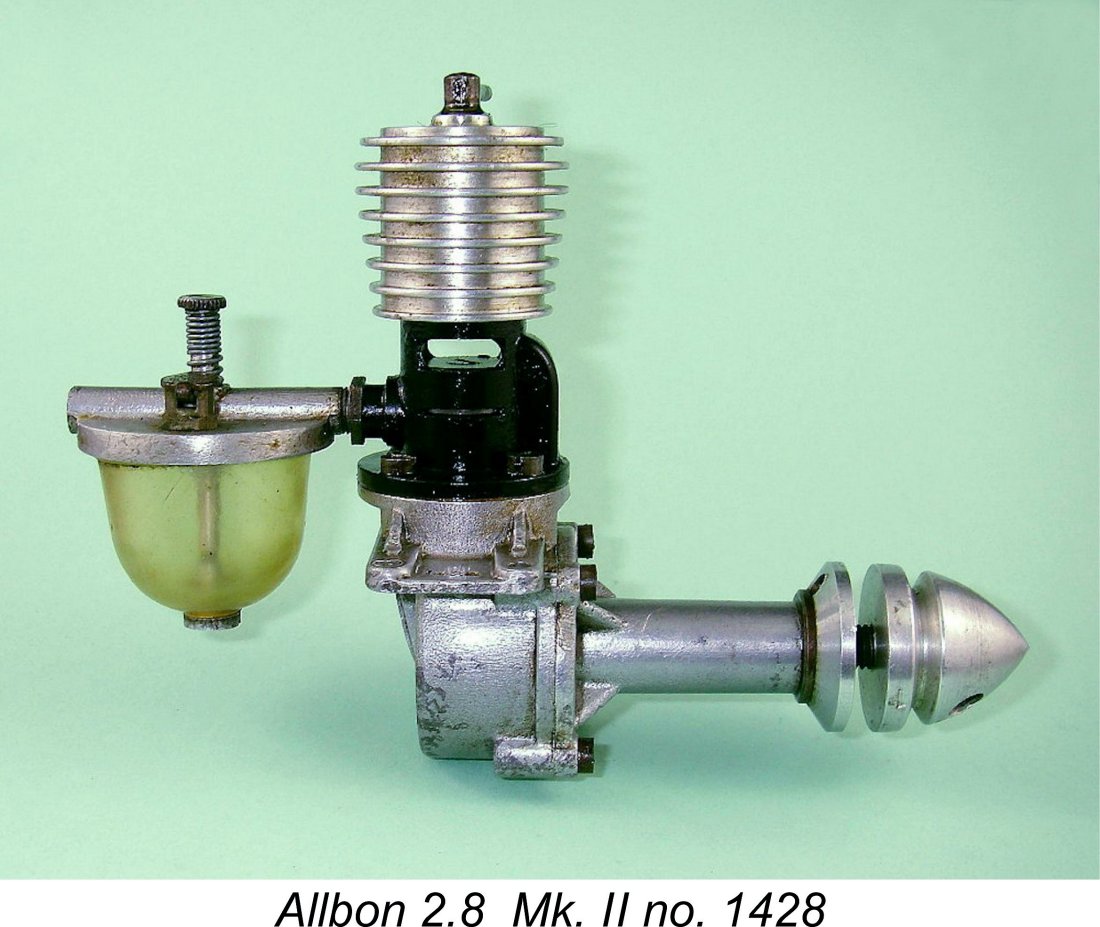 What can I say about these results?!? They certainly don't bear out the Allbon advertising claim of "Peak R.P.M. 2,000 Higher" for the Mk. II version! Come to that, neither did the figures reported by Sparey. I suppose the results must be put down to those indefinable differences between two examples of the same product (which these are apart from the two Mk. II cylinder modifications) that can undoubtedly affect relative performance in ways which defy rational analysis.
What can I say about these results?!? They certainly don't bear out the Allbon advertising claim of "Peak R.P.M. 2,000 Higher" for the Mk. II version! Come to that, neither did the figures reported by Sparey. I suppose the results must be put down to those indefinable differences between two examples of the same product (which these are apart from the two Mk. II cylinder modifications) that can undoubtedly affect relative performance in ways which defy rational analysis.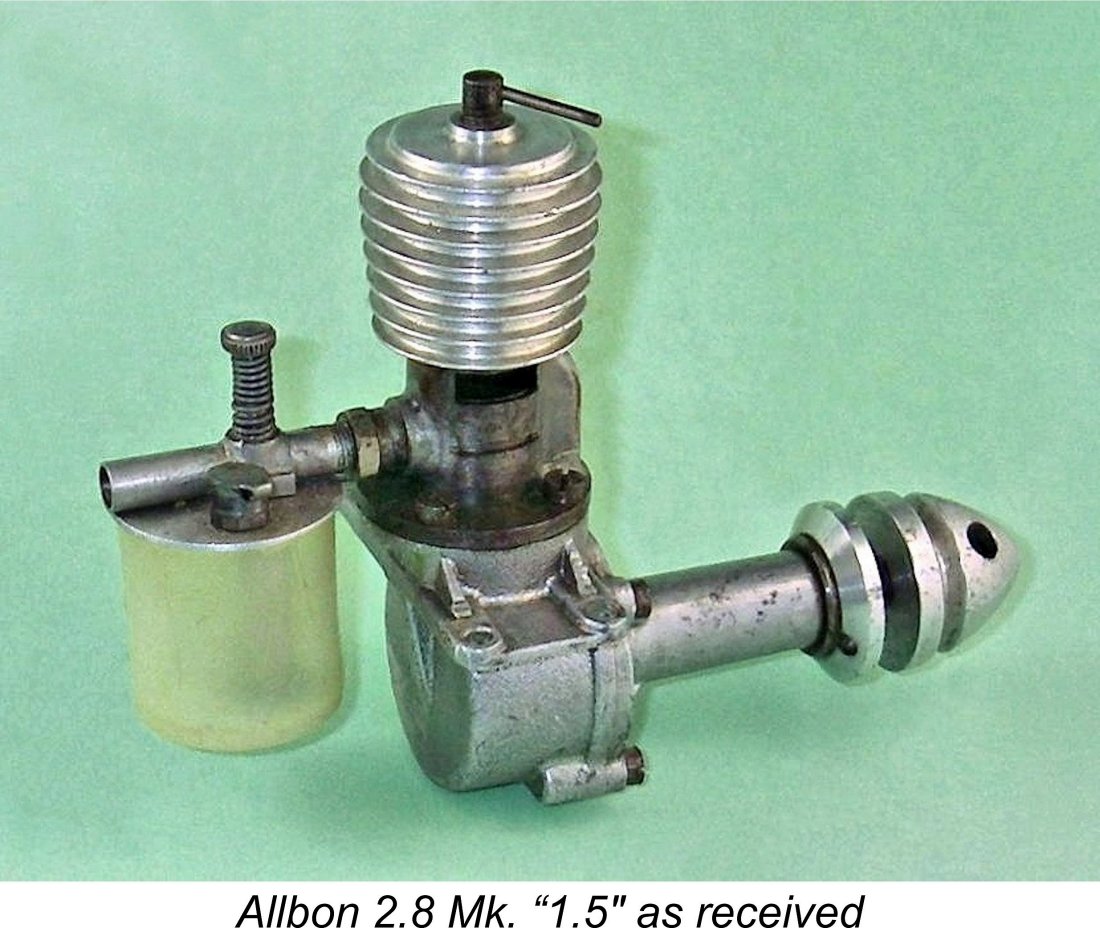 It's a very strange thing, and a phenomenon which I really can't explain, that the publication of one of my articles very often coincides with the near-simultaneous acquisition from a completely independent source of further information relating to the topic. Perhaps it's simply that my attention becomes closely focused upon the subject, with a consequently heightened awareness of such opportunities. Be that as it may, my original article proved to be no exception - immediately following its initial publication on MEN in December 2012, another example of the Allbon 2.8 came my way which proved to have a most interesting tale to tell!
It's a very strange thing, and a phenomenon which I really can't explain, that the publication of one of my articles very often coincides with the near-simultaneous acquisition from a completely independent source of further information relating to the topic. Perhaps it's simply that my attention becomes closely focused upon the subject, with a consequently heightened awareness of such opportunities. Be that as it may, my original article proved to be no exception - immediately following its initial publication on MEN in December 2012, another example of the Allbon 2.8 came my way which proved to have a most interesting tale to tell!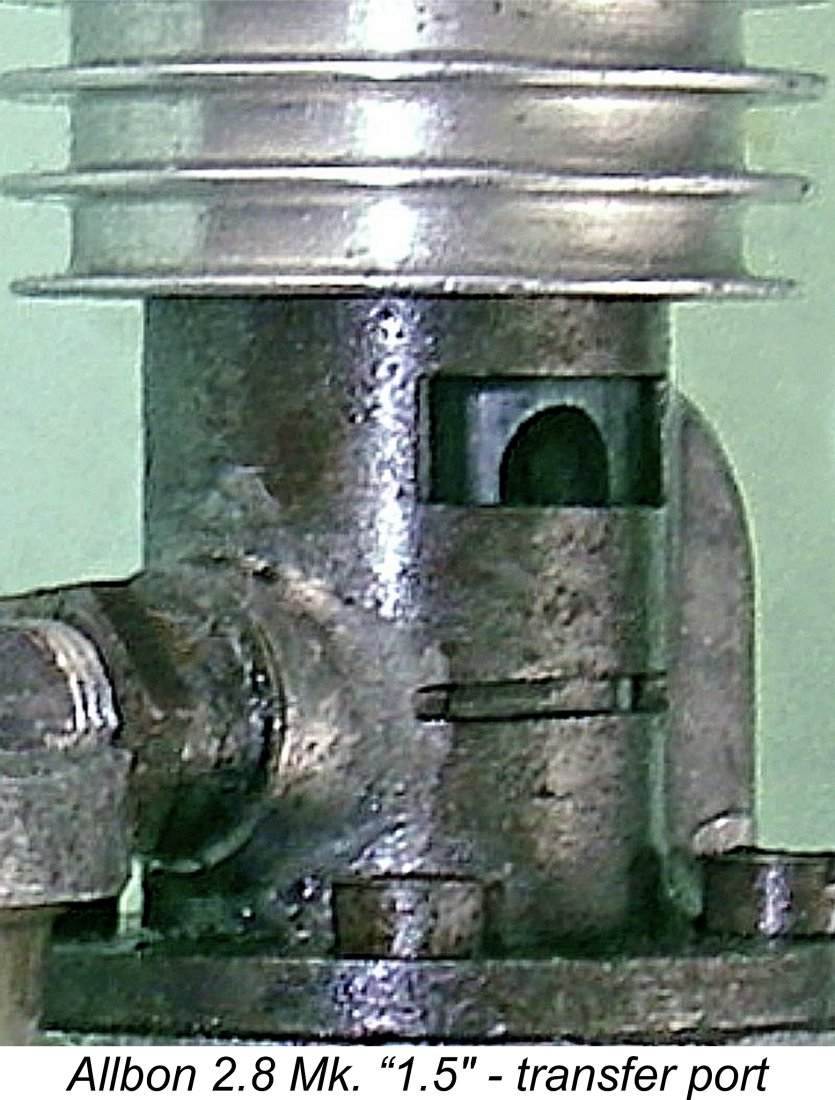 Further examination revealed that the engine exhibited another significant departure from the Mk. II pattern, and this time one which could not be explained as a result of wear and tear. This was the fact that the top of the transfer port remained round as in the Mk. I models, with no evidence whatsoever of any attempt to square it off as in the Mk. II. The engine was undoubtedly assembled in this configuration at the factory - obviously, the squaring-off of the port is not reversible.
Further examination revealed that the engine exhibited another significant departure from the Mk. II pattern, and this time one which could not be explained as a result of wear and tear. This was the fact that the top of the transfer port remained round as in the Mk. I models, with no evidence whatsoever of any attempt to square it off as in the Mk. II. The engine was undoubtedly assembled in this configuration at the factory - obviously, the squaring-off of the port is not reversible. 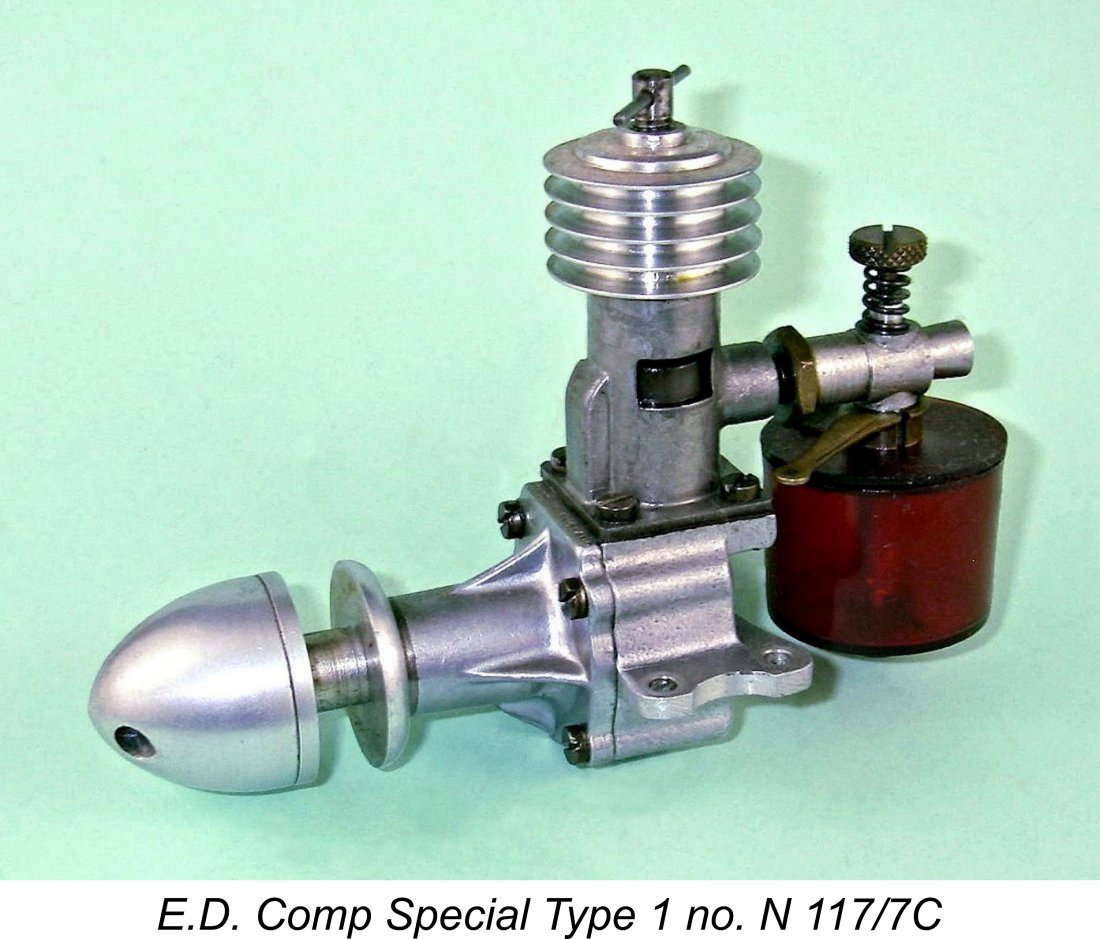 contribute nothing to the tests. Finally, why bother adding a serial number to a factory test engine? The new example displays all of the above characteristics. Its unmarked condition would be explained by the fact that most of its previous running had been confined to the test bench.
contribute nothing to the tests. Finally, why bother adding a serial number to a factory test engine? The new example displays all of the above characteristics. Its unmarked condition would be explained by the fact that most of its previous running had been confined to the test bench.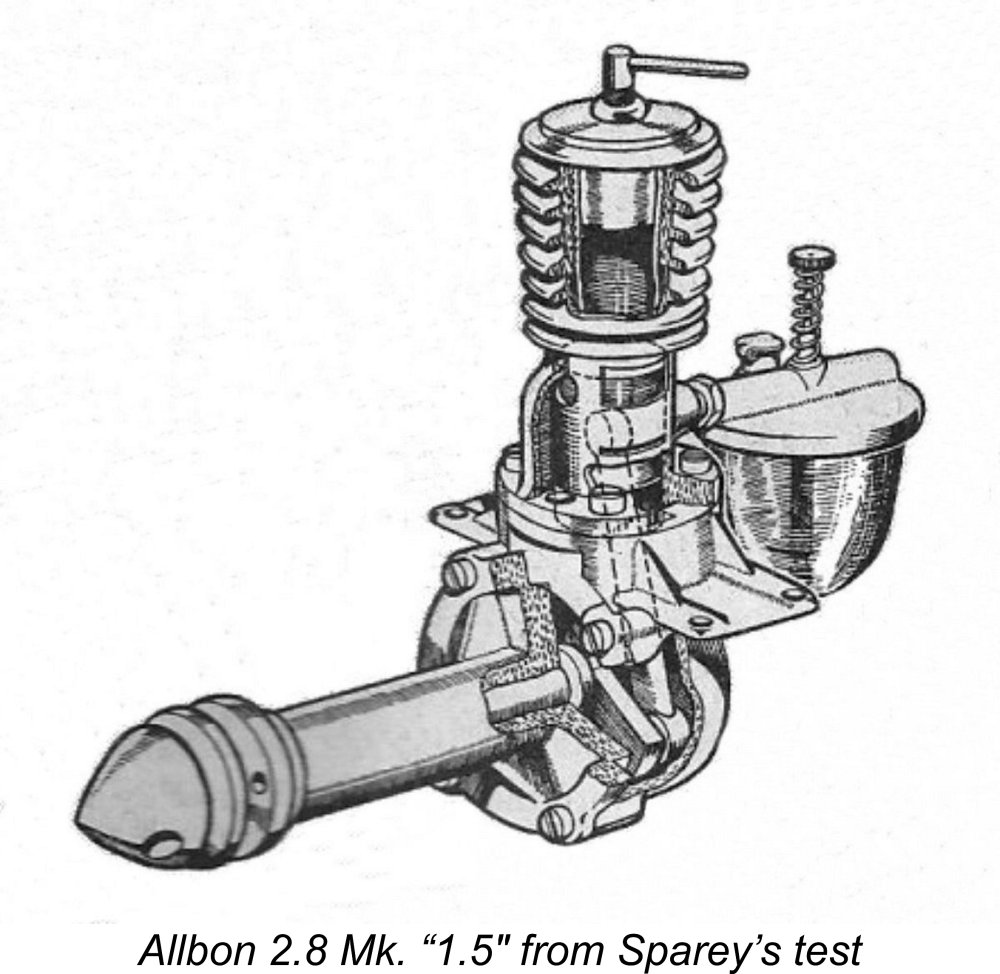 This raises the possibility, amounting in my view to a probability, that Sparey had been one of the individuals favoured with a test example of this intermediate “Mk. 1.5” type, and that it was this example that was featured in his published test. This view is supported by the fact that a close inspection of the very clear cutaway drawing of the engine which was included in Sparey’s test report shows that it did indeed have a round upper transfer port to go along with the two sub-piston induction slots, making it a “Mk. 1.5” beyond a doubt. The timing is exactly right, plus the fact that Sparey did not characterize his tested unit as a Mk. II (which had yet to be announced at the time when he conducted his test) despite the undoubted presence of the sub-piston induction slots is entirely consistent with the above scenario. Indeed, it's difficult to explain the appearance of the sub-piston slots several months in advance of the announcement of the Mk. II in any other way.
This raises the possibility, amounting in my view to a probability, that Sparey had been one of the individuals favoured with a test example of this intermediate “Mk. 1.5” type, and that it was this example that was featured in his published test. This view is supported by the fact that a close inspection of the very clear cutaway drawing of the engine which was included in Sparey’s test report shows that it did indeed have a round upper transfer port to go along with the two sub-piston induction slots, making it a “Mk. 1.5” beyond a doubt. The timing is exactly right, plus the fact that Sparey did not characterize his tested unit as a Mk. II (which had yet to be announced at the time when he conducted his test) despite the undoubted presence of the sub-piston induction slots is entirely consistent with the above scenario. Indeed, it's difficult to explain the appearance of the sub-piston slots several months in advance of the announcement of the Mk. II in any other way.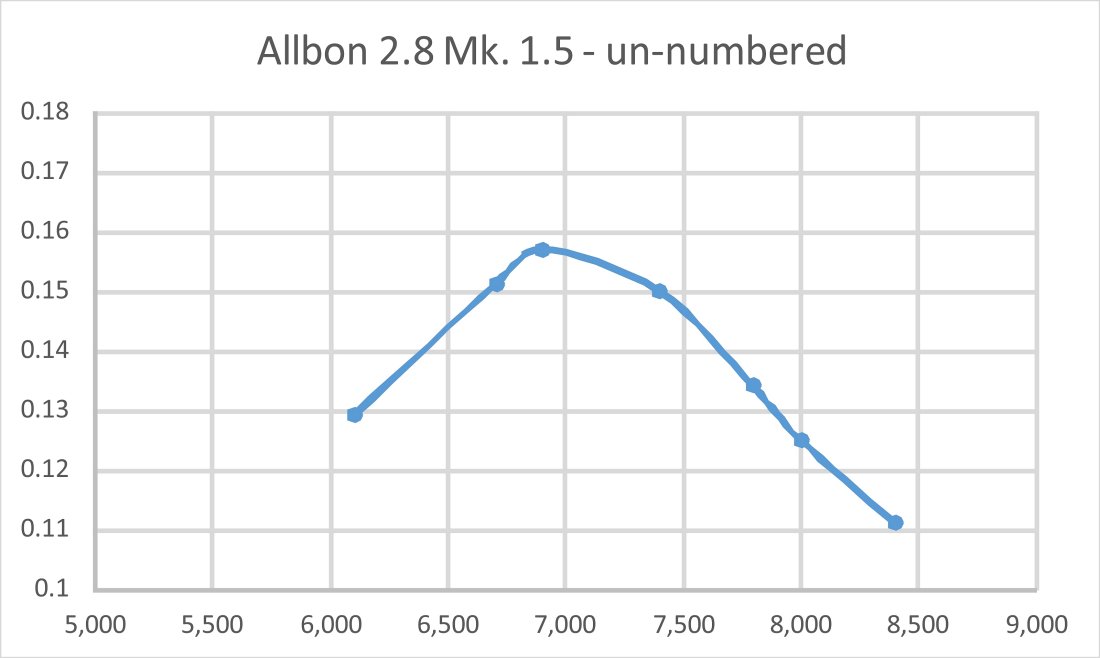
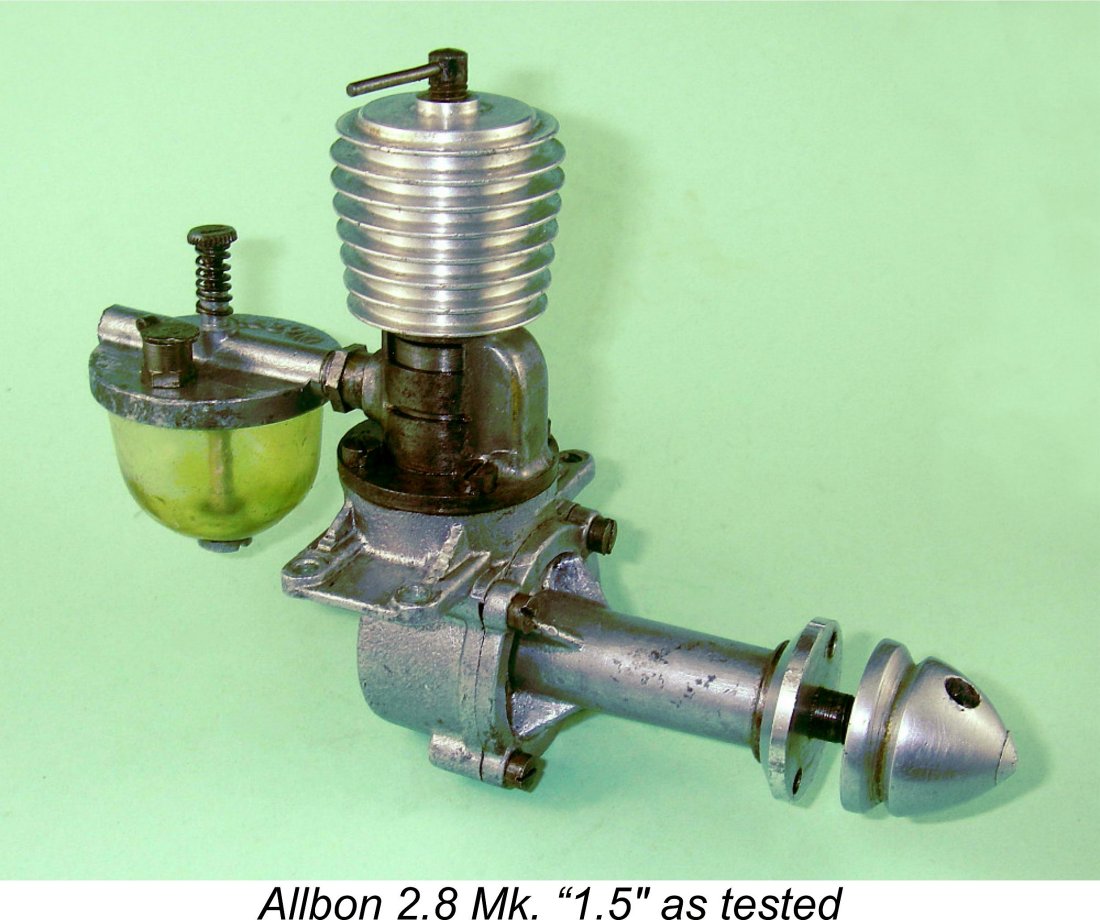 The Mk. 1.5 also performed at a level which was streets ahead of my Mk. II example no. 1428. I have to conclude either that my example of the Mk. II failed to meet its potential during the test which I conducted or that the squared-off transfer port actually reduces performance. In reality, if that had been the case there's no way that Alan Allbon would have included it in the final design of the Mk. II model. I suspect that I simply have a "slow" example, or one that requires more running time.
The Mk. 1.5 also performed at a level which was streets ahead of my Mk. II example no. 1428. I have to conclude either that my example of the Mk. II failed to meet its potential during the test which I conducted or that the squared-off transfer port actually reduces performance. In reality, if that had been the case there's no way that Alan Allbon would have included it in the final design of the Mk. II model. I suspect that I simply have a "slow" example, or one that requires more running time.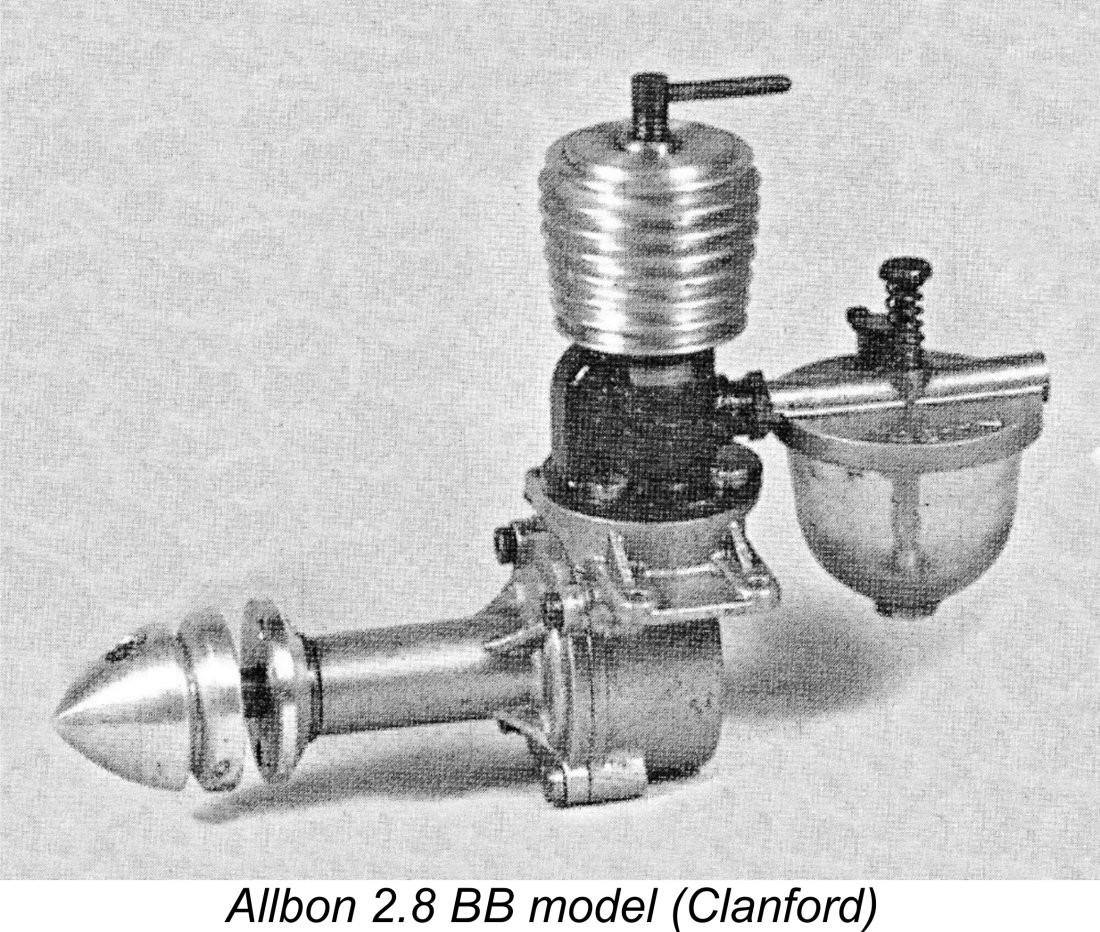 Whatever may be said about the above analysis, it's clear that by late 1948 the Allbon 2.8 had been developed into a very useful engine for non-competition purposes. However, Allbon didn't stop at this point. The next step in the engine's development was to reduce friction losses by adding a ball race shaft to the mix. A revised front housing was produced which accommodated a single ball-race at the rear of the shaft in its most heavily-loaded location. This required that the recesses between the main bearing stiffening braces be filled in, making these units instantly recognizable.
Whatever may be said about the above analysis, it's clear that by late 1948 the Allbon 2.8 had been developed into a very useful engine for non-competition purposes. However, Allbon didn't stop at this point. The next step in the engine's development was to reduce friction losses by adding a ball race shaft to the mix. A revised front housing was produced which accommodated a single ball-race at the rear of the shaft in its most heavily-loaded location. This required that the recesses between the main bearing stiffening braces be filled in, making these units instantly recognizable. 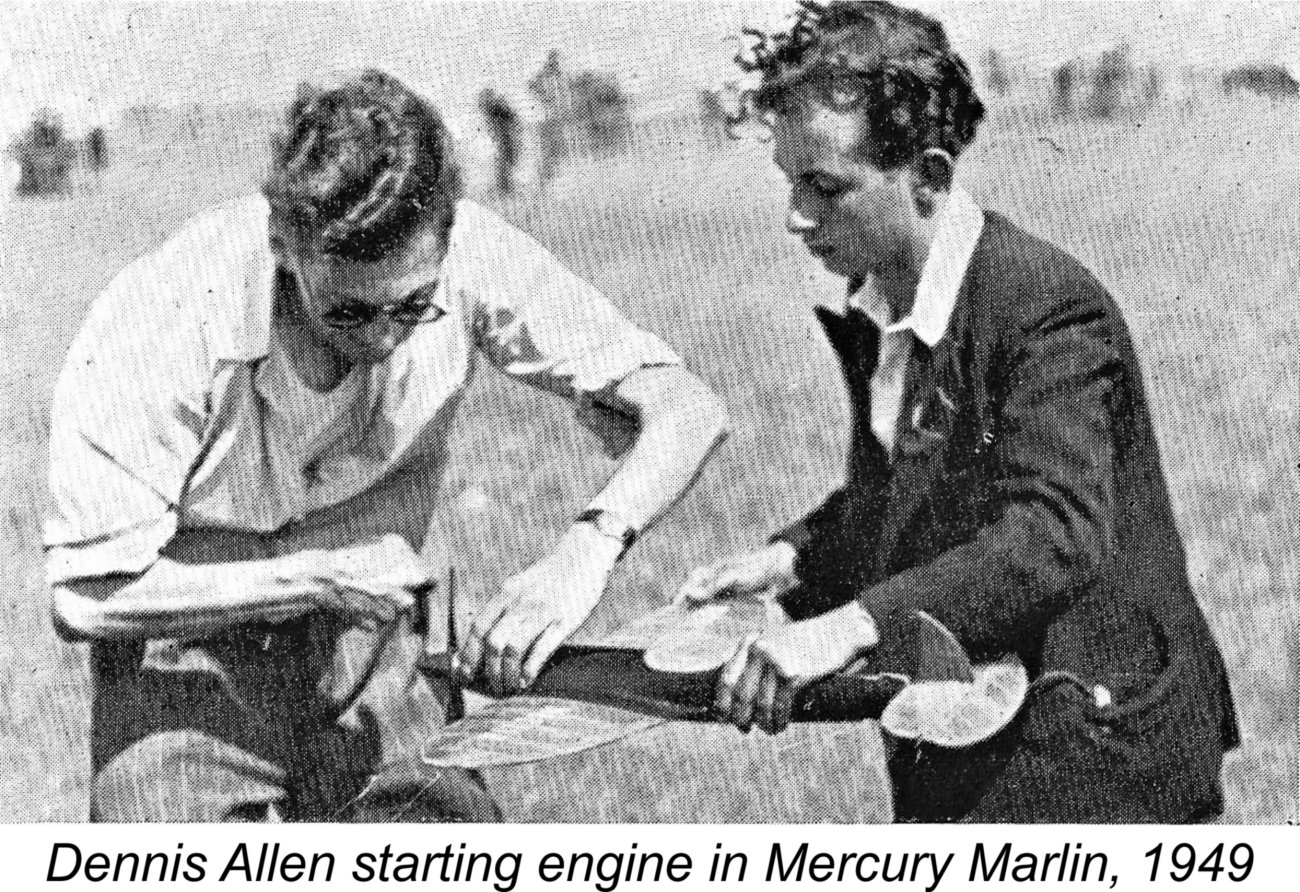 West Essex club and a noted pioneering control-line stunt flier with some very well-known model designs like the "Boxcar" to his credit. He knew model engines very well indeed, both as a practical user and on account of his employment with the engine repair service operated by Henry J. Nicholls as an adjunct to his famous shop at 308 Holloway Road in London. Since Nicholls had been the distributor and servicing agent for the Allbon 2.8 since its introduction at the beginning of 1948, Allen already had a close familiarity with that engine.
West Essex club and a noted pioneering control-line stunt flier with some very well-known model designs like the "Boxcar" to his credit. He knew model engines very well indeed, both as a practical user and on account of his employment with the engine repair service operated by Henry J. Nicholls as an adjunct to his famous shop at 308 Holloway Road in London. Since Nicholls had been the distributor and servicing agent for the Allbon 2.8 since its introduction at the beginning of 1948, Allen already had a close familiarity with that engine.